-
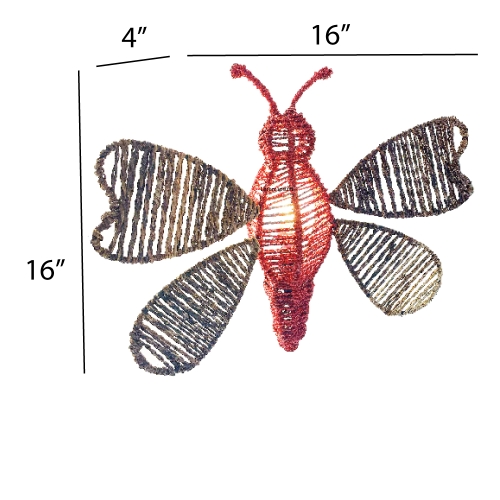
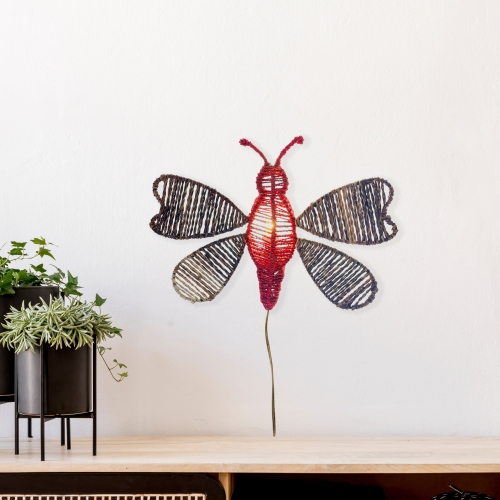 This butterfly is large and bold with its striking bright red body. But this butterfly isn't mono-colored. Instead, the artist uses natural earth tones within its wings to create contrast and warmth. This piece adds fun on its own but can have even larger impact if placed in a group with a few friends! The butterfly's wings are comprised of natural abaca rope handwoven into a wrought iron frame. The head and body is made of abaca twine, stained, and then handwoven into the same wrought iron fame, emphasizing the contrast between the body and wings. Abaca is a fiber of a plant that is related to the banana plant. It bears no fruit, but it can continuously grow from the same roots similar to native grasses. The open weaving allows for ambient light to show through providing functional light. Also included is a plug with an inline switch for easy use.
This butterfly is large and bold with its striking bright red body. But this butterfly isn't mono-colored. Instead, the artist uses natural earth tones within its wings to create contrast and warmth. This piece adds fun on its own but can have even larger impact if placed in a group with a few friends! The butterfly's wings are comprised of natural abaca rope handwoven into a wrought iron frame. The head and body is made of abaca twine, stained, and then handwoven into the same wrought iron fame, emphasizing the contrast between the body and wings. Abaca is a fiber of a plant that is related to the banana plant. It bears no fruit, but it can continuously grow from the same roots similar to native grasses. The open weaving allows for ambient light to show through providing functional light. Also included is a plug with an inline switch for easy use. -
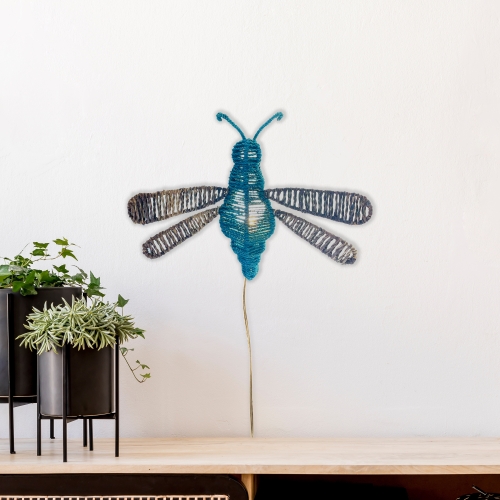
 Reflecting the natural aquas and blues of the nearly translucent dragonfly, the artist uses a base of sea blue dyed abaca weave to embody the almost ephemeral structure. The wings feature a natural abaca rope mimicking the texture of a dragonfly's organic wing structure. This piece adds fun on its own but can have even larger impact if placed in a group with a few friends! The dragonfly's wings are comprised of natural abaca rope handwoven into a wrought iron frame. The head and body is made of abaca twine, stained, and then handwoven into the same wrought iron fame, emphasizing the contrast between the body and wings. Abaca is a fiber of a plant that is related to the banana plant. It bears no fruit, but it can continuously grow from the same roots similar to native grasses. The open weaving allows for ambient light to show through providing functional light. Also included is a plug with an inline switch for easy use.
Reflecting the natural aquas and blues of the nearly translucent dragonfly, the artist uses a base of sea blue dyed abaca weave to embody the almost ephemeral structure. The wings feature a natural abaca rope mimicking the texture of a dragonfly's organic wing structure. This piece adds fun on its own but can have even larger impact if placed in a group with a few friends! The dragonfly's wings are comprised of natural abaca rope handwoven into a wrought iron frame. The head and body is made of abaca twine, stained, and then handwoven into the same wrought iron fame, emphasizing the contrast between the body and wings. Abaca is a fiber of a plant that is related to the banana plant. It bears no fruit, but it can continuously grow from the same roots similar to native grasses. The open weaving allows for ambient light to show through providing functional light. Also included is a plug with an inline switch for easy use. -
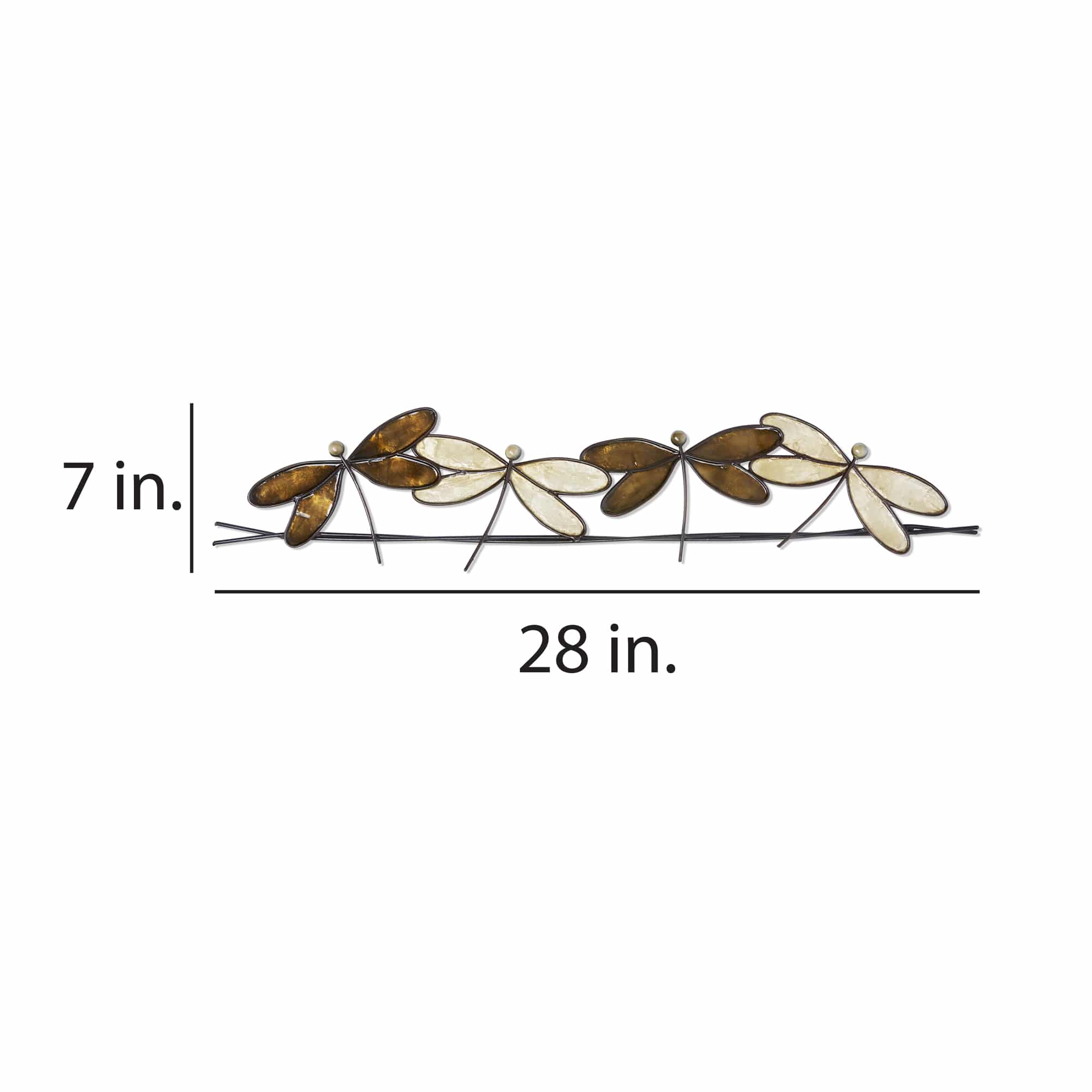
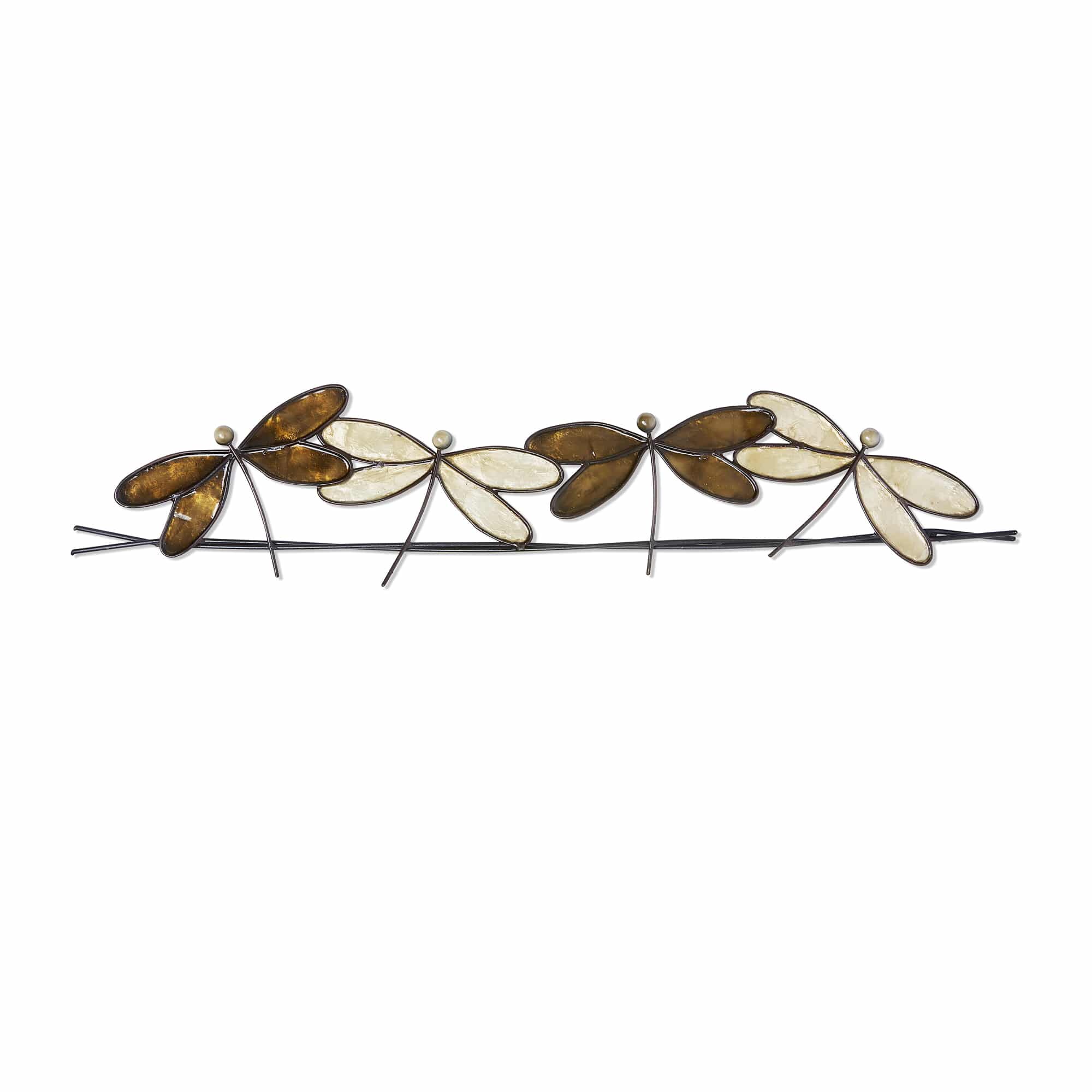
Four dragonflies are taking a mid-day break from fluttering and their characteristically unpredictable flight patterns around the lake. The slender, metal body of each dragonfly connects to colorful, capiz-shell wings, which catches light and adds shine. Each wing is framed using sturdy wrought iron and reinforced with a metal backing.
The basic frame of the dragonfly is created using tin, which is powder-coated with a black finish and makes this piece safe to use outdoors. The edges of the frame are reinforced using thicker tin wire. The front of this piece is adorned in areas with capiz shell, an oyster native to the Philippines, before being hand-painted and sealed with a water-based sealant. The primary purpose of this oyster to provide a source of food, however, the shell is a sustainable by-product that can be used for decoration. The capiz shell subtly replicates the reflective qualities of dragonflies in nature. The entire piece is lightweight and has an eyelet in the back allowing it to be hung using a finishing nail, command strip, or a push pin. Due to it being a natural material, the organic colors of capiz come through as tans and browns underneath the paint.
-
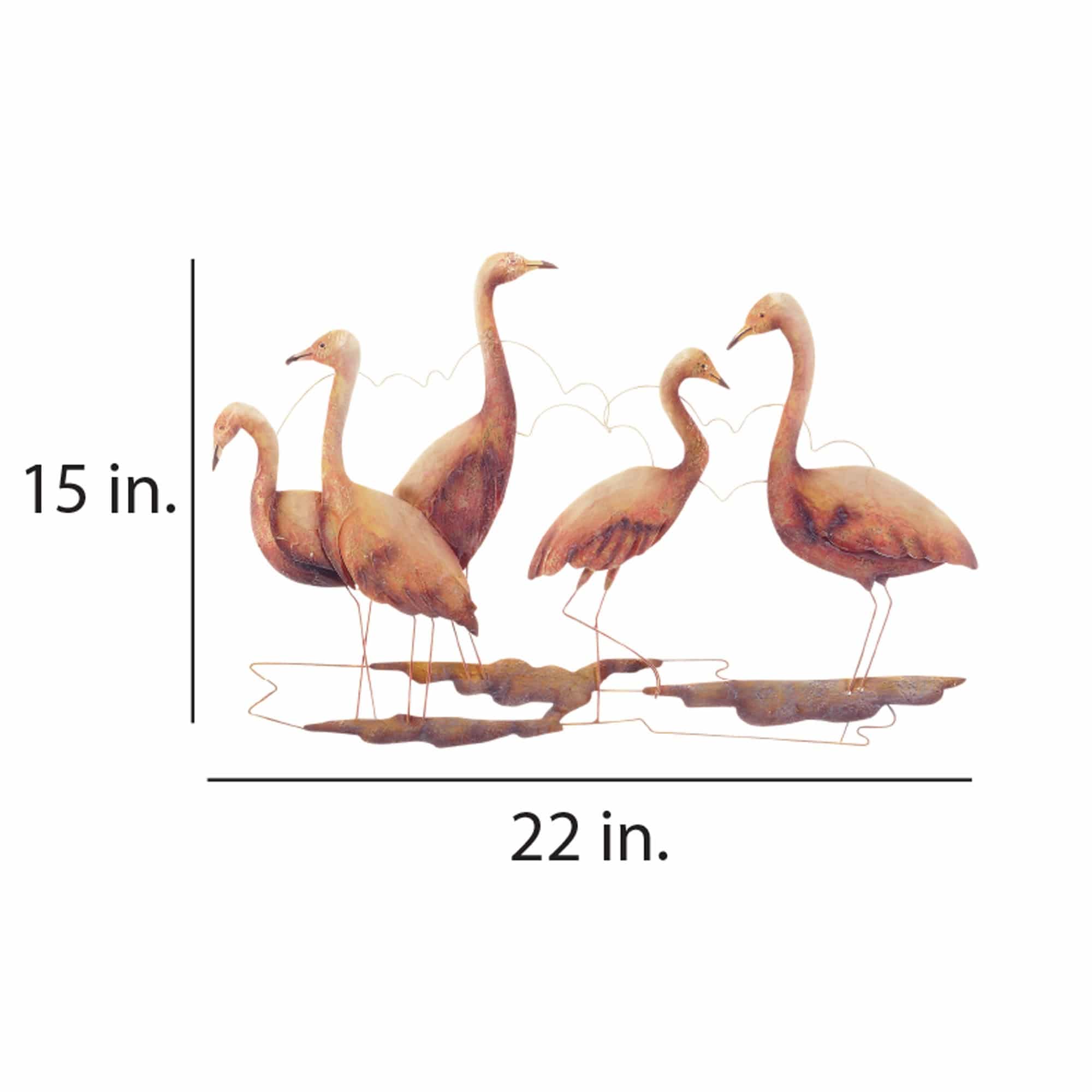
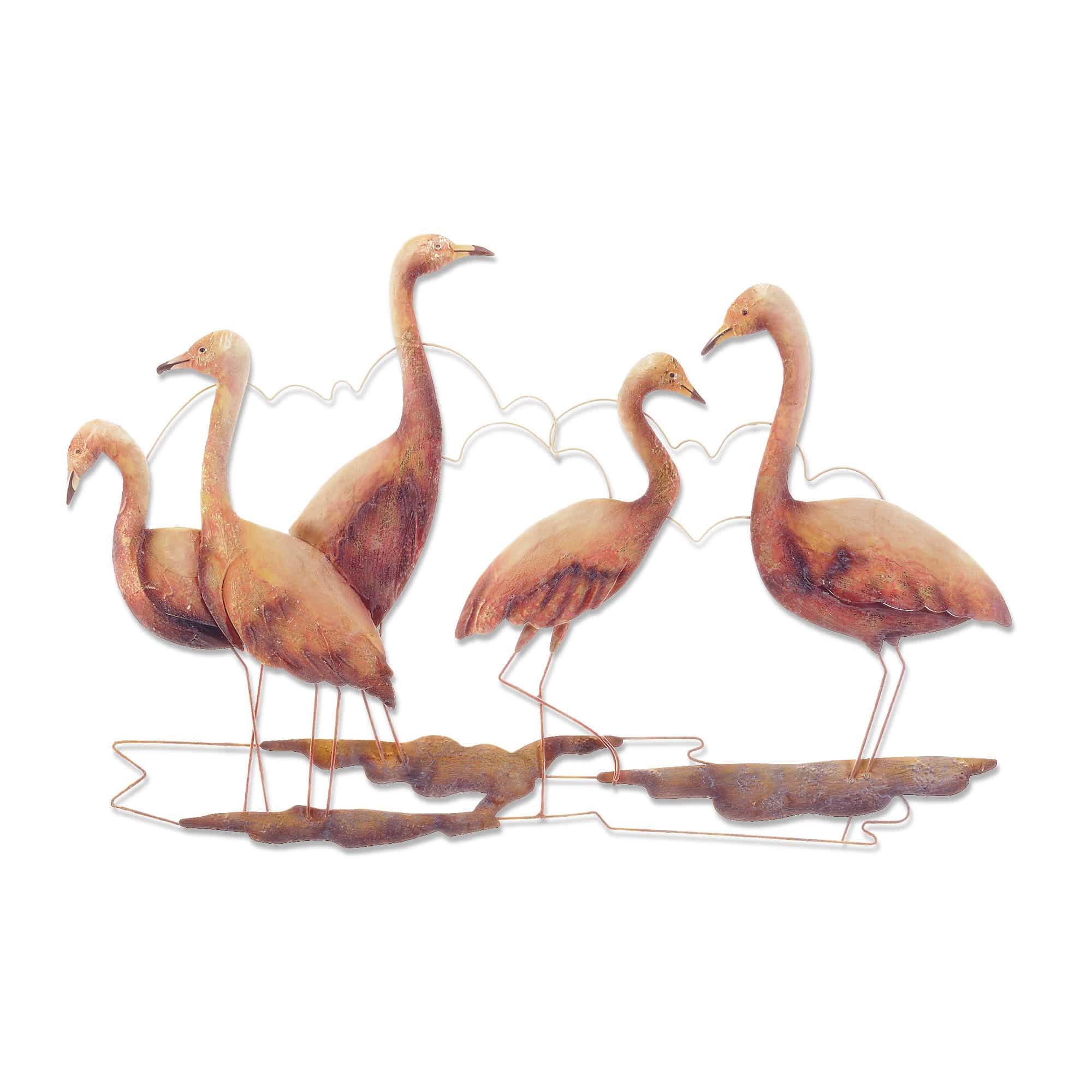 The name 'flamingo' comes from the Portuguese or Spanish 'flamengo,' which means 'flame-colored.' Born gray in hues, flamingos get their flamboyant color from brine shrimp that make up most of their diet. Flamingos are very social animals and the artist depicts this by creating a group of five birds wading through the calm water enjoying a warm day. The artist takes time in pressing the metal creating texture in the wings and body, and also uses metallic paints to highlight the famous colors of one of the most recognizable birds on the planet. The basic frame of this piece is created using tin, which is powder coated with a black finish. The frame is reinforced using tin wire along the inner edge. The front of the body is adorned with capiz. Capiz is an oyster shell and the primary purpose of the oyster is as a source of food. However, the by-product, the shell, can be used for decoration. Due to it being a natural material, the natural colors of the capiz may come through as tans and browns underneath the hand-painted surface.
The name 'flamingo' comes from the Portuguese or Spanish 'flamengo,' which means 'flame-colored.' Born gray in hues, flamingos get their flamboyant color from brine shrimp that make up most of their diet. Flamingos are very social animals and the artist depicts this by creating a group of five birds wading through the calm water enjoying a warm day. The artist takes time in pressing the metal creating texture in the wings and body, and also uses metallic paints to highlight the famous colors of one of the most recognizable birds on the planet. The basic frame of this piece is created using tin, which is powder coated with a black finish. The frame is reinforced using tin wire along the inner edge. The front of the body is adorned with capiz. Capiz is an oyster shell and the primary purpose of the oyster is as a source of food. However, the by-product, the shell, can be used for decoration. Due to it being a natural material, the natural colors of the capiz may come through as tans and browns underneath the hand-painted surface. -
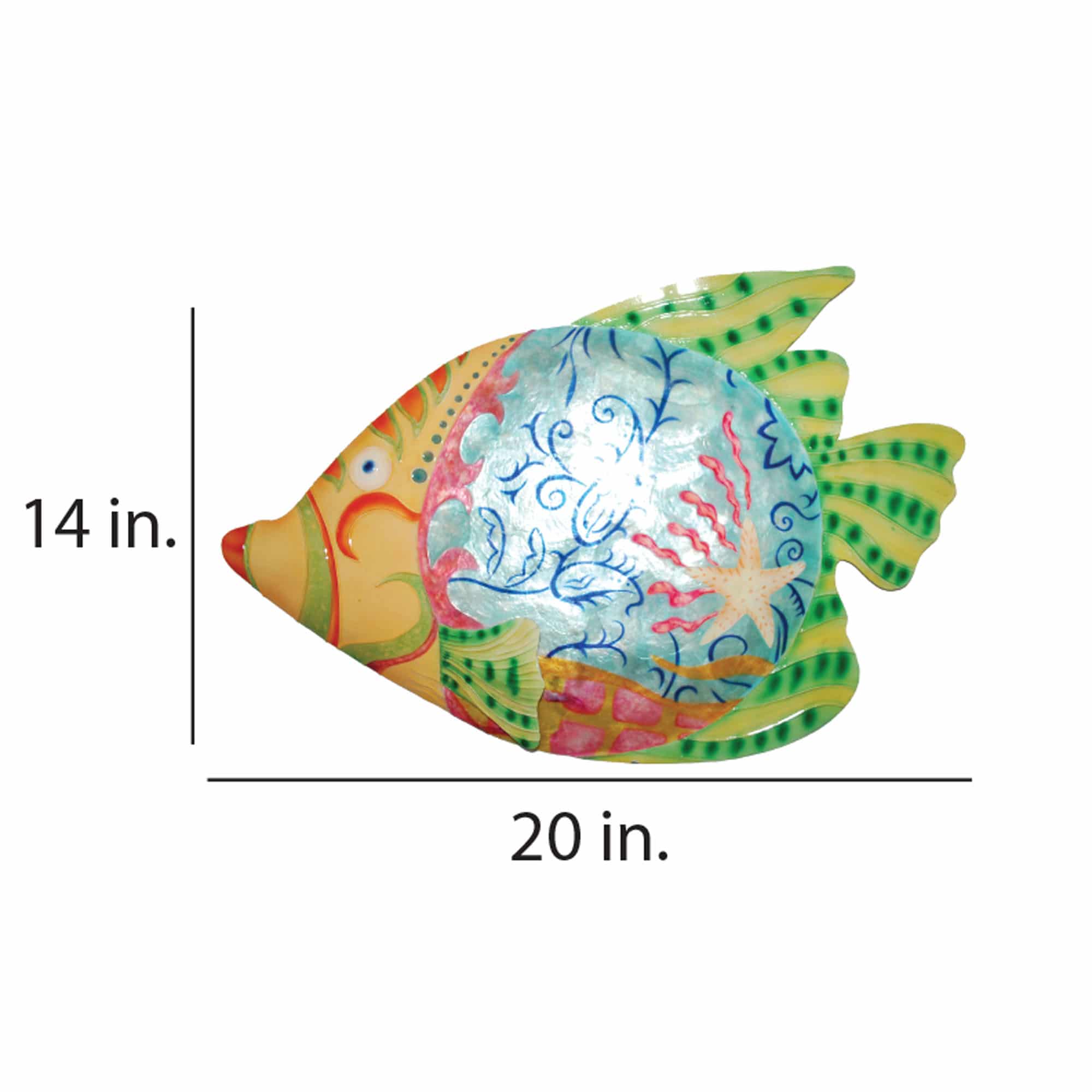
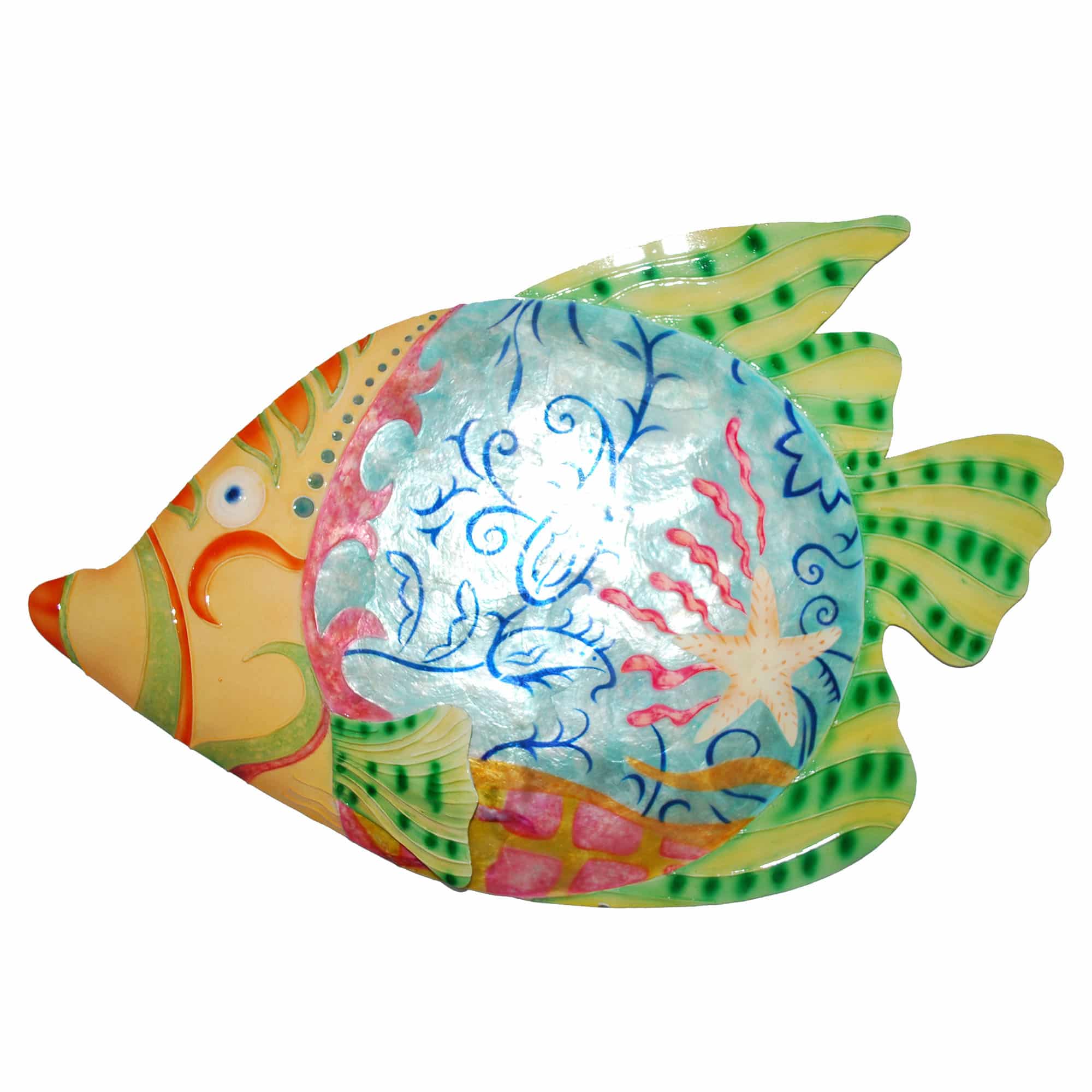 This piece-of-art is influenced not only by nature, but also different cultures of the world. The frame is of a butterflyfish, which are commonly found in reefs of the Atlantic, Indian, and Pacific Oceans. The colors and swirls painted onto the fish are commonly seen in those reefs among the different plants and animals that reside there. The style in which the fish is painted represents an artistic style commonly seen in the Caribbean. The artist also creates slight contrasts between the body of the fish using capiz oyster shells and the matted outer fins and face. The body will reflect light making it seem bolder. All the components come together creating a fun and global piece. The basic frame of this piece is created using tin, which is powder coated with a black finish. The frame is reinforced using tin wire along the inner edge. The front of the body is adorned with capiz. Capiz is an oyster shell and the primary purpose of the oyster is as a source of food. However, the by-product, the shell, can be used for decoration. Due to it being a natural material, the natural colors of the capiz may come through as tans and browns underneath the hand-painted surface.
This piece-of-art is influenced not only by nature, but also different cultures of the world. The frame is of a butterflyfish, which are commonly found in reefs of the Atlantic, Indian, and Pacific Oceans. The colors and swirls painted onto the fish are commonly seen in those reefs among the different plants and animals that reside there. The style in which the fish is painted represents an artistic style commonly seen in the Caribbean. The artist also creates slight contrasts between the body of the fish using capiz oyster shells and the matted outer fins and face. The body will reflect light making it seem bolder. All the components come together creating a fun and global piece. The basic frame of this piece is created using tin, which is powder coated with a black finish. The frame is reinforced using tin wire along the inner edge. The front of the body is adorned with capiz. Capiz is an oyster shell and the primary purpose of the oyster is as a source of food. However, the by-product, the shell, can be used for decoration. Due to it being a natural material, the natural colors of the capiz may come through as tans and browns underneath the hand-painted surface. -
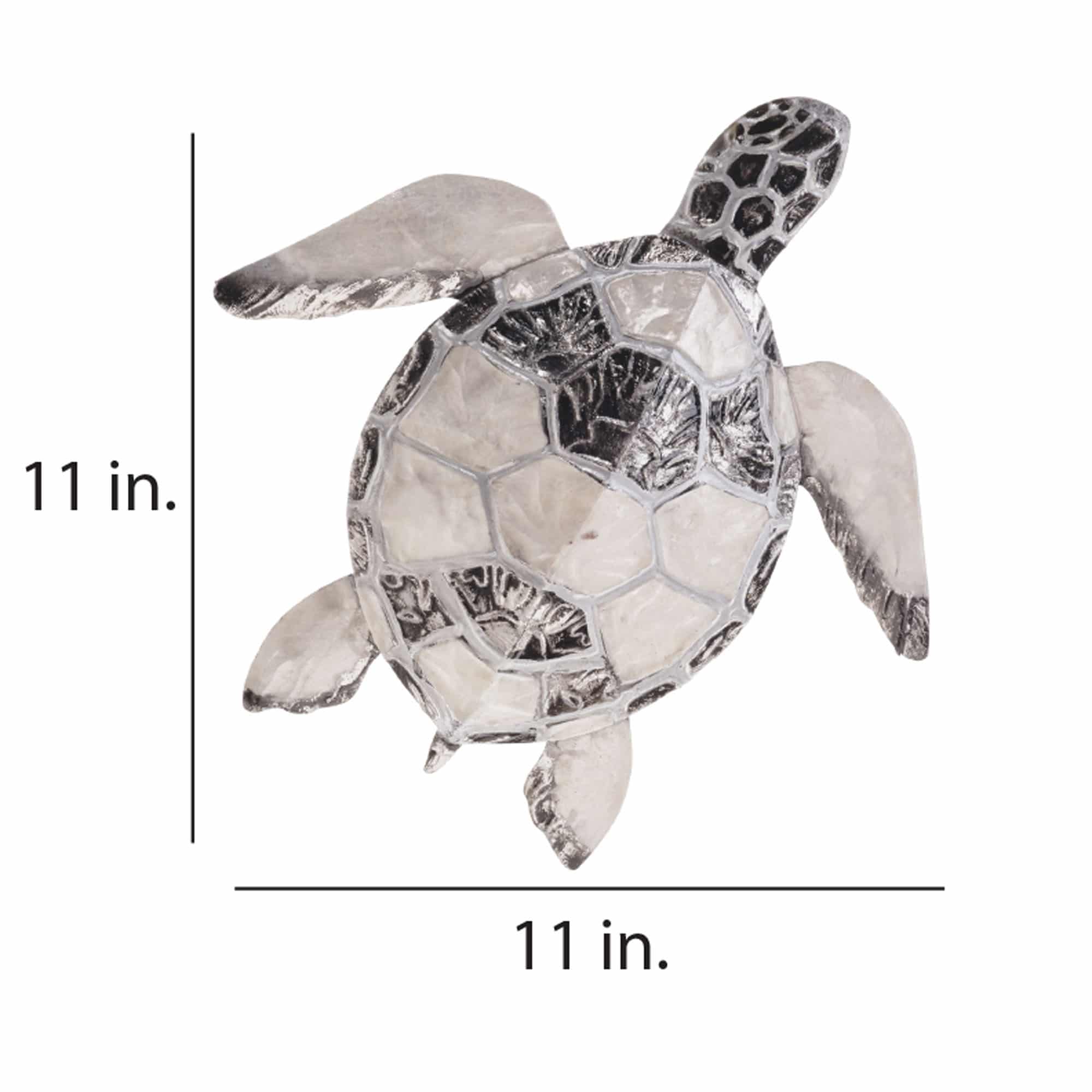
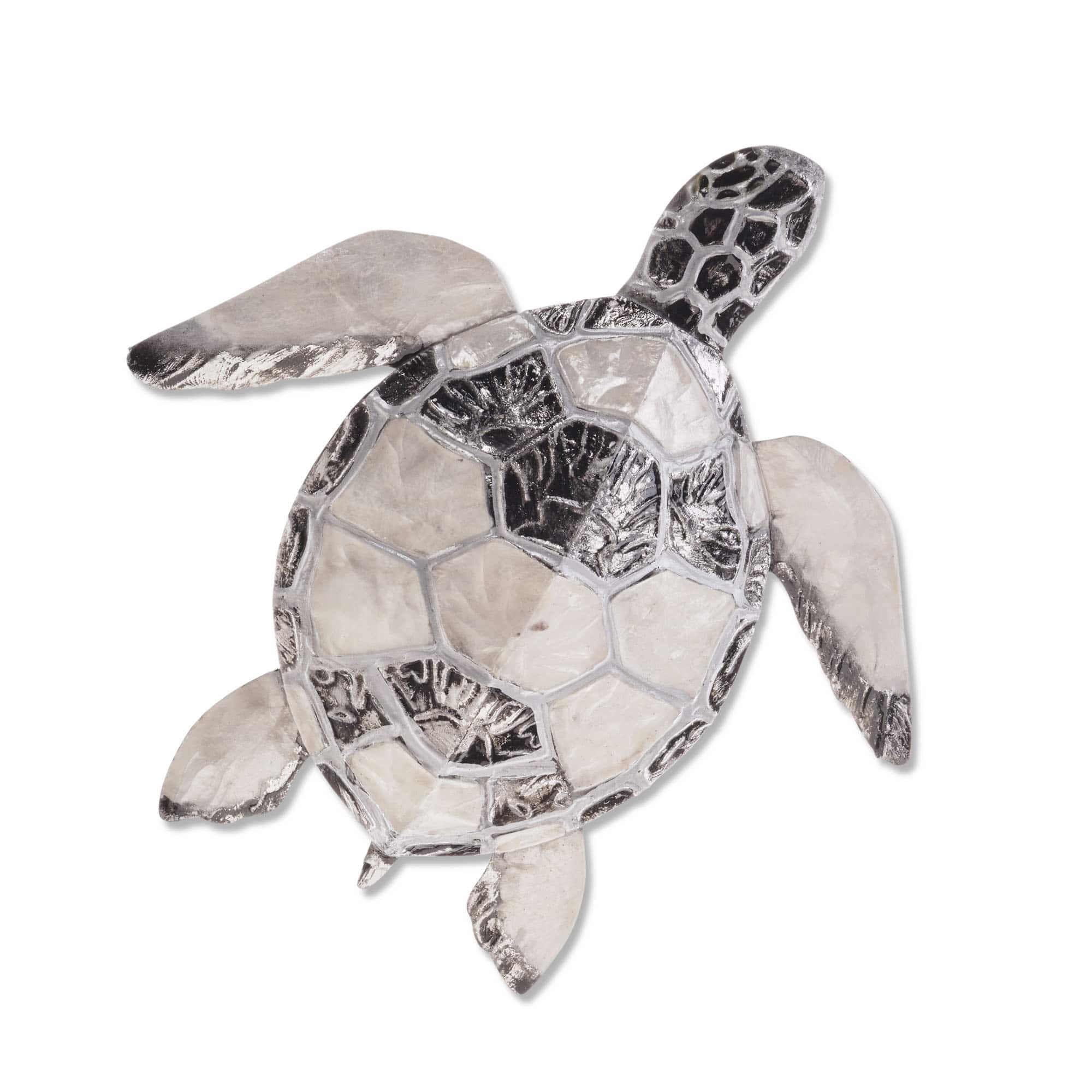 Sea turtles are among the most ancient species on this planet. Today there are seven species of sea turtle remaining that date back 110 million years, back to the age of the dinosaurs. This piece features the Loggerhead turtle, one of the most recognizable of all the sea. This creature is known for its scaled skin, which the artist carefully etches into the metal of the turtle's head and throughout the tips and edges of its body. The shell of the turtle glistens which the artist recreates using capiz shell. The focus of this awe-inspiring piece is the texture and size of sea turtles and the artist uses contrasting colors to underscore this fact. The basic frame of the turtle is created using tin, which is powder coated with a black finish. The frame is reinforced using tin wire along the inner edge. Capiz is an oyster shell and the primary purpose of the oyster is as a source of food. However, the by-product, the shell, can be used for decoration. Due to it being a natural material, the natural colors of the capiz come through as tans and browns underneath the paint. The shell is then painted the bold colors you see. The entire front facing piece is carefully hand-painted keeping in mind the reflective qualities in the color of turtles.
Sea turtles are among the most ancient species on this planet. Today there are seven species of sea turtle remaining that date back 110 million years, back to the age of the dinosaurs. This piece features the Loggerhead turtle, one of the most recognizable of all the sea. This creature is known for its scaled skin, which the artist carefully etches into the metal of the turtle's head and throughout the tips and edges of its body. The shell of the turtle glistens which the artist recreates using capiz shell. The focus of this awe-inspiring piece is the texture and size of sea turtles and the artist uses contrasting colors to underscore this fact. The basic frame of the turtle is created using tin, which is powder coated with a black finish. The frame is reinforced using tin wire along the inner edge. Capiz is an oyster shell and the primary purpose of the oyster is as a source of food. However, the by-product, the shell, can be used for decoration. Due to it being a natural material, the natural colors of the capiz come through as tans and browns underneath the paint. The shell is then painted the bold colors you see. The entire front facing piece is carefully hand-painted keeping in mind the reflective qualities in the color of turtles. -
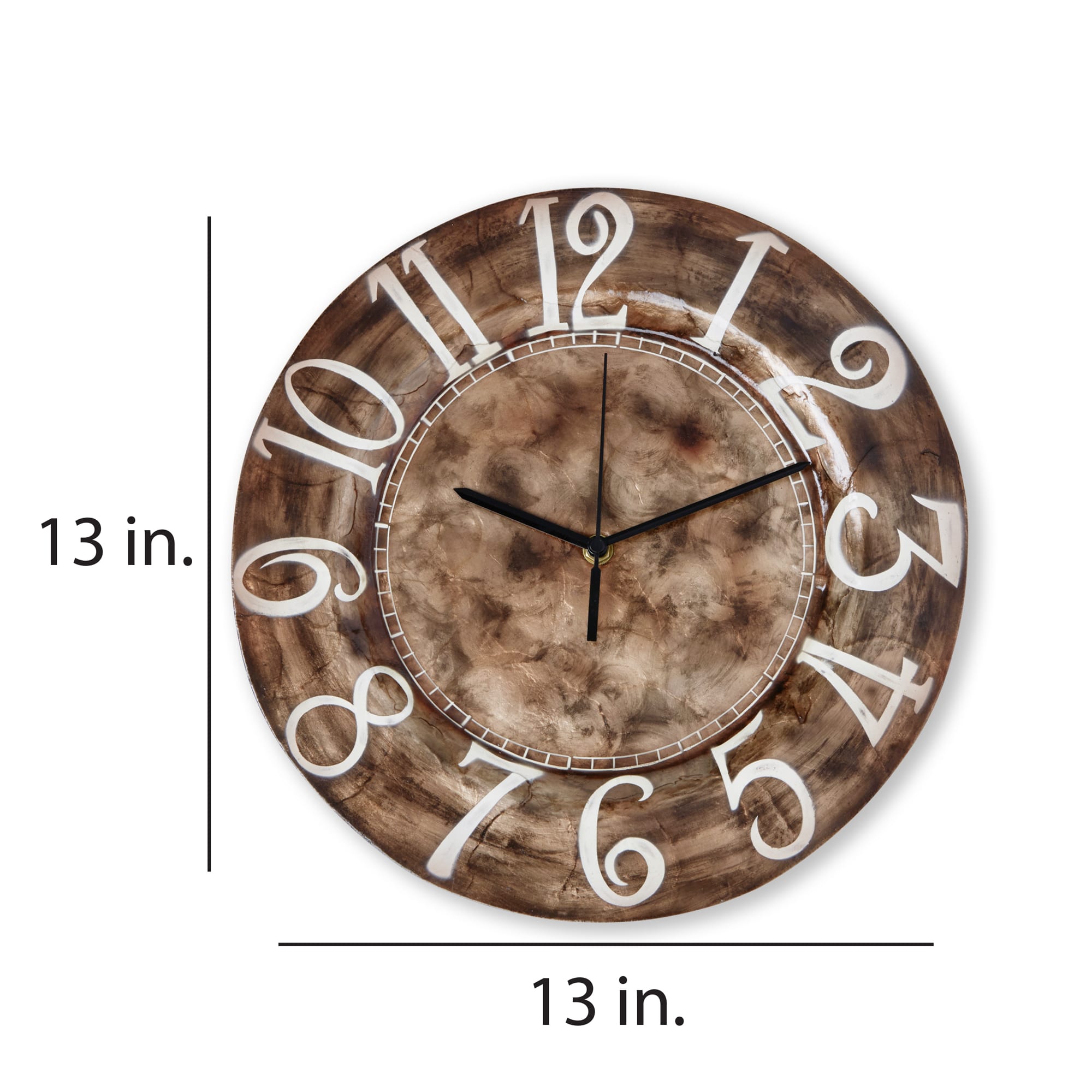
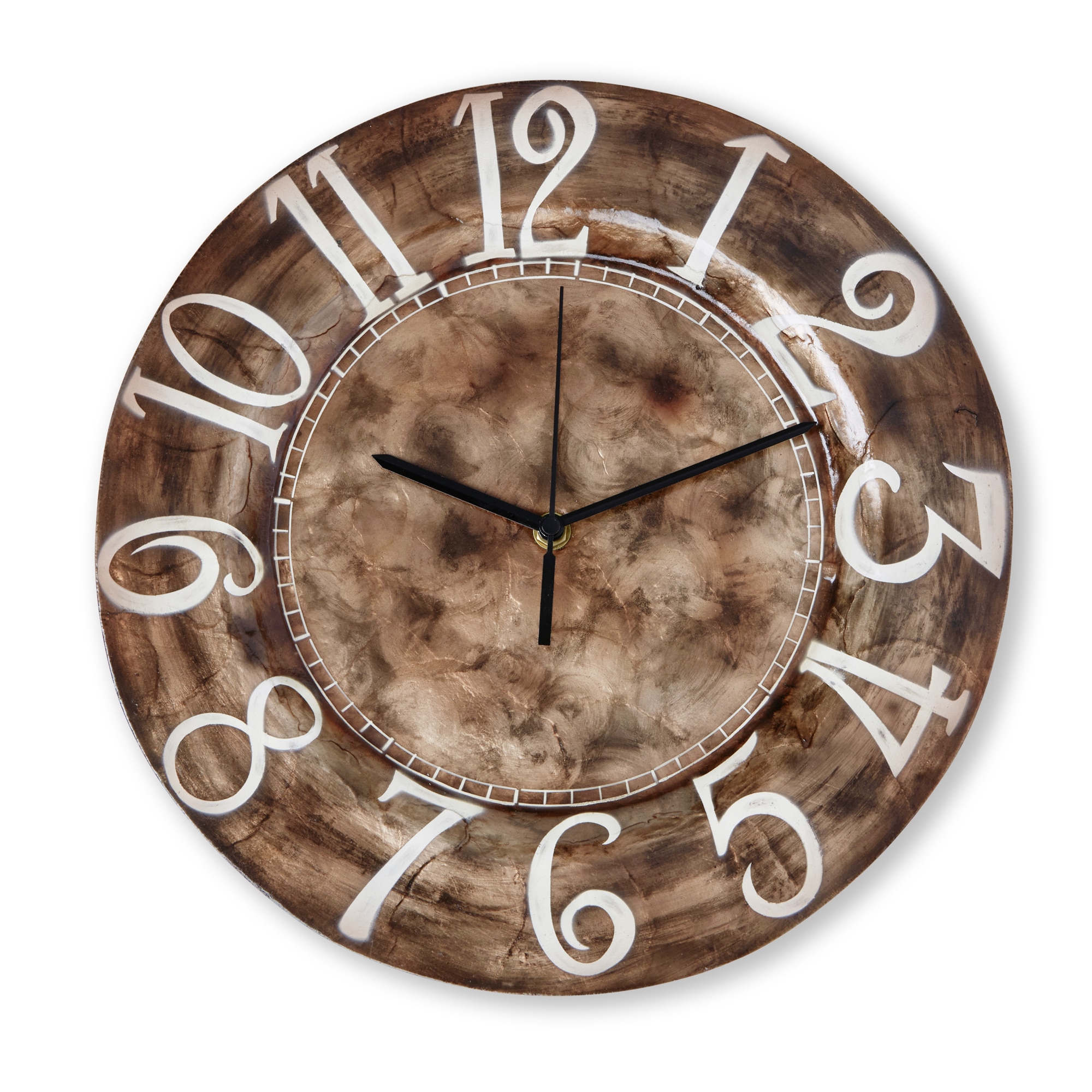 The frame of this clock is made with solid capiz oyster shell, compressed into shape. The texture and lines of the individual shell pieces still come through the broad brush strokes of brown on the background of the clock. The distressed look of the earthy, rich background color giving an aged feel which is complemented by the added detail of the weathered, hand-painted numbers. Capiz is an oyster shell and the primary purpose of the oyster is as a source of food. However, the by-product, the shell, can be used for decoration. The clock is created by compressing capiz shell together and forming it into shape. The final result is a light-weight, plate that feels similar to plastic. Due to it being a natural material, the natural colors of the capiz may come through as tans and browns underneath the hand-painted surface.
The frame of this clock is made with solid capiz oyster shell, compressed into shape. The texture and lines of the individual shell pieces still come through the broad brush strokes of brown on the background of the clock. The distressed look of the earthy, rich background color giving an aged feel which is complemented by the added detail of the weathered, hand-painted numbers. Capiz is an oyster shell and the primary purpose of the oyster is as a source of food. However, the by-product, the shell, can be used for decoration. The clock is created by compressing capiz shell together and forming it into shape. The final result is a light-weight, plate that feels similar to plastic. Due to it being a natural material, the natural colors of the capiz may come through as tans and browns underneath the hand-painted surface. -

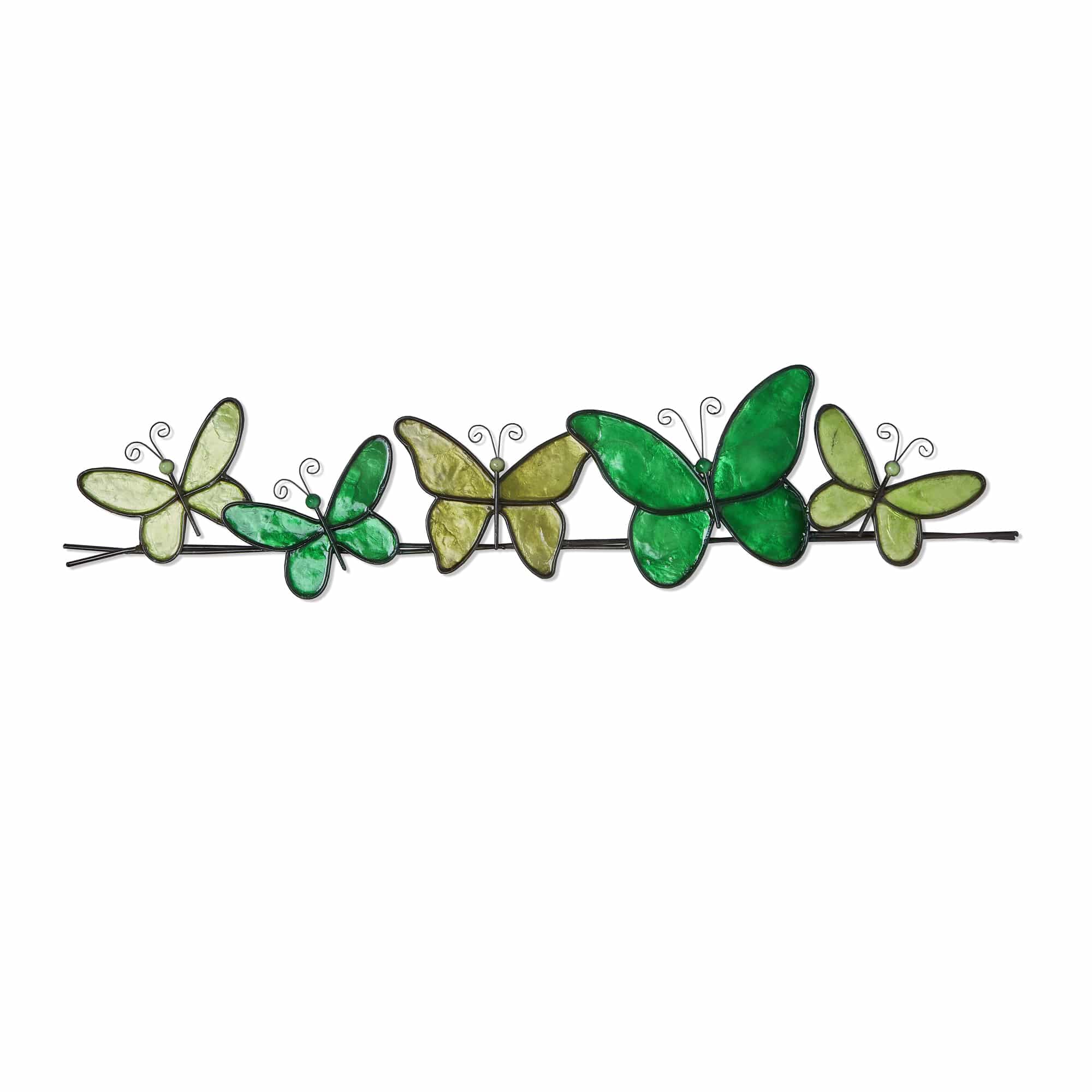 Five, fluttering butterflies are ready to complete their journey after taking a break from a long migration. The slender, metal body of each butterfly connects to colorful capiz-shell wings which catches light and adds shine. Each wing is framed using sturdy wrought iron and reinforced with a metal backing. The basic frame of the butterfly is created using tin, which is powder-coated with a black finish and makes this piece safe to use outdoors. The edges of the frame are reinforced using thicker tin wire. The front of this piece is adorned in areas with capiz shell, an oyster native to the Philippines, before being hand-painted and sealed with a water-based sealant. The primary purpose of this oyster to provide a source of food, however, the shell is a sustainable by-product that can be used for decoration. The capiz shell subtly replicates the reflective qualities of butterflies in nature. The entire piece is lightweight and has an eyelet in the back allowing it to be hung using a finishing nail, command strip, or a push pin. Due to it being a natural material, the organic colors of capiz come through as tans and browns underneath the paint.
Five, fluttering butterflies are ready to complete their journey after taking a break from a long migration. The slender, metal body of each butterfly connects to colorful capiz-shell wings which catches light and adds shine. Each wing is framed using sturdy wrought iron and reinforced with a metal backing. The basic frame of the butterfly is created using tin, which is powder-coated with a black finish and makes this piece safe to use outdoors. The edges of the frame are reinforced using thicker tin wire. The front of this piece is adorned in areas with capiz shell, an oyster native to the Philippines, before being hand-painted and sealed with a water-based sealant. The primary purpose of this oyster to provide a source of food, however, the shell is a sustainable by-product that can be used for decoration. The capiz shell subtly replicates the reflective qualities of butterflies in nature. The entire piece is lightweight and has an eyelet in the back allowing it to be hung using a finishing nail, command strip, or a push pin. Due to it being a natural material, the organic colors of capiz come through as tans and browns underneath the paint. -
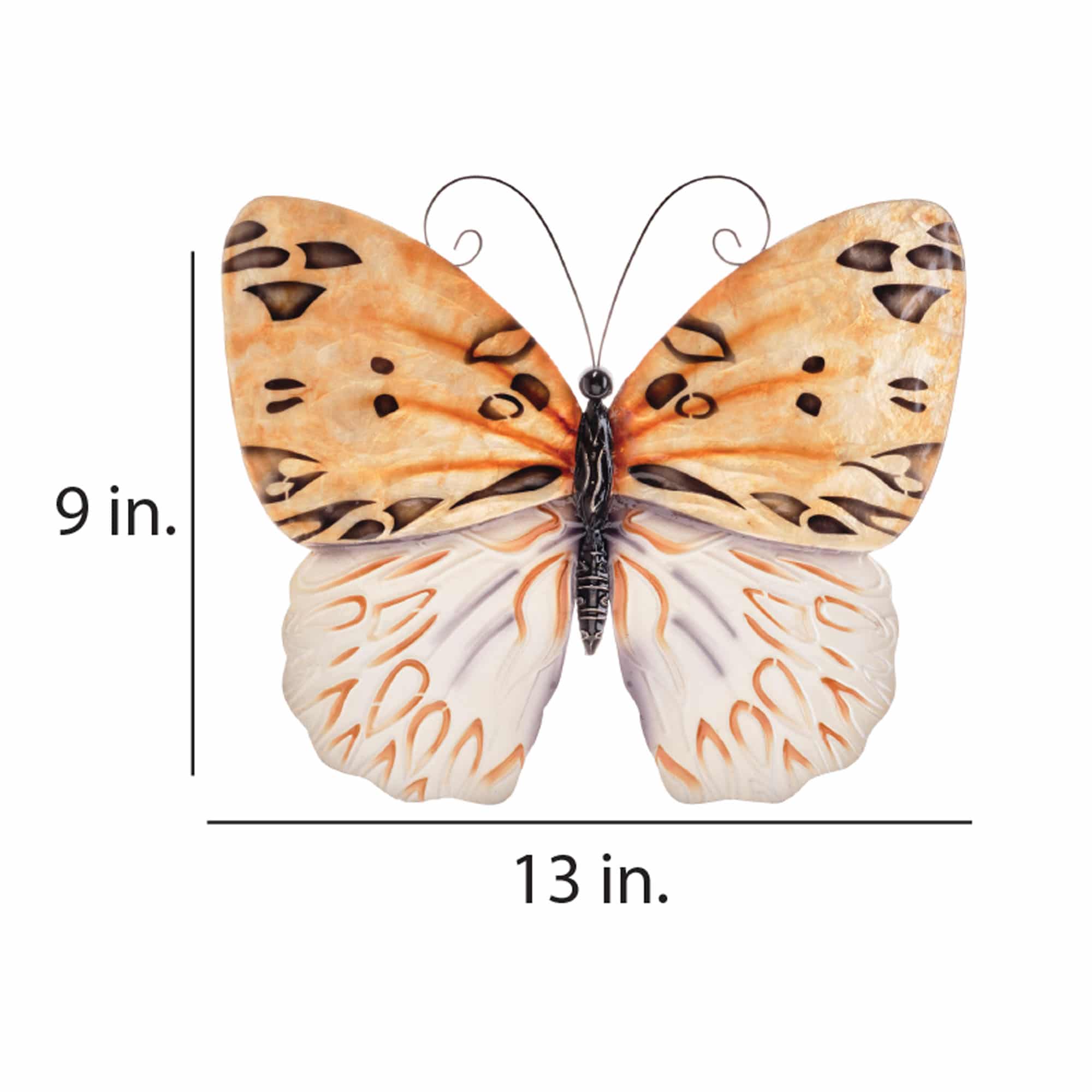
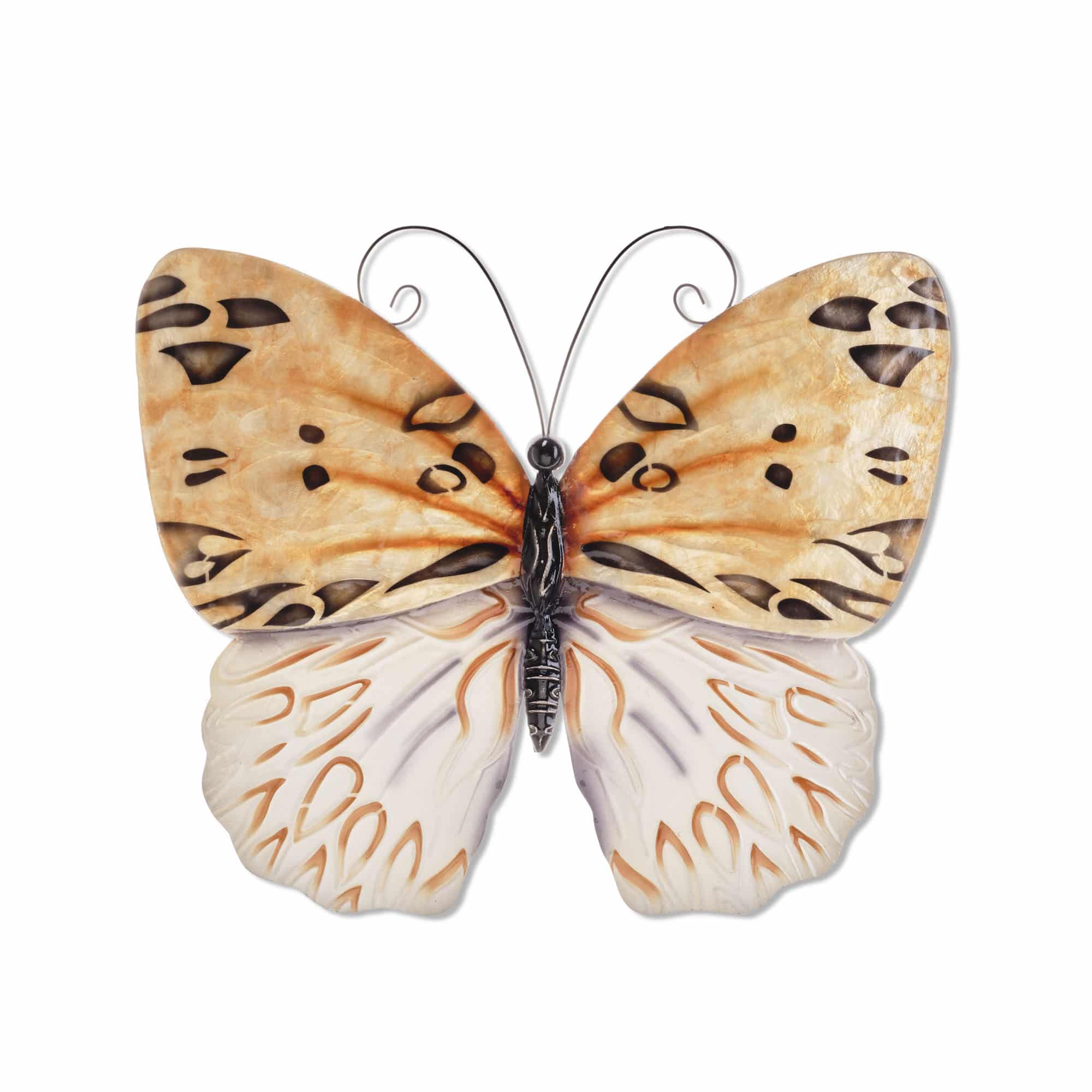
Using paints of various shades and different hues of yellow, this graceful butterfly features an appearance of flowing honey on its upper wings. The lower wings diverge from the honey and are textured in a base white color with highlights of yellow. Stylish and elegant, this piece adds sophistication to the finish of any room, contemporary or traditional.
The basic frame of the butterfly is created using tin, which is powder-coated with a black finish and makes this piece safe to use outdoors. The edges of the frame are reinforced using thicker tin wire. The front of this piece is adorned in areas with capiz shell, an oyster native to the Philippines, before being hand-painted and sealed with a water-based sealant. The primary purpose of this oyster to provide a source of food, however, the shell is a sustainable by-product that can be used for decoration. The capiz shell subtly replicates the reflective qualities of butterflies in nature. The entire piece is lightweight and has an eyelet in the back allowing it to be hung using a finishing nail, command strip, or a push pin. Due to it being a natural material, the organic colors of capiz come through as tans and browns underneath the paint.
-
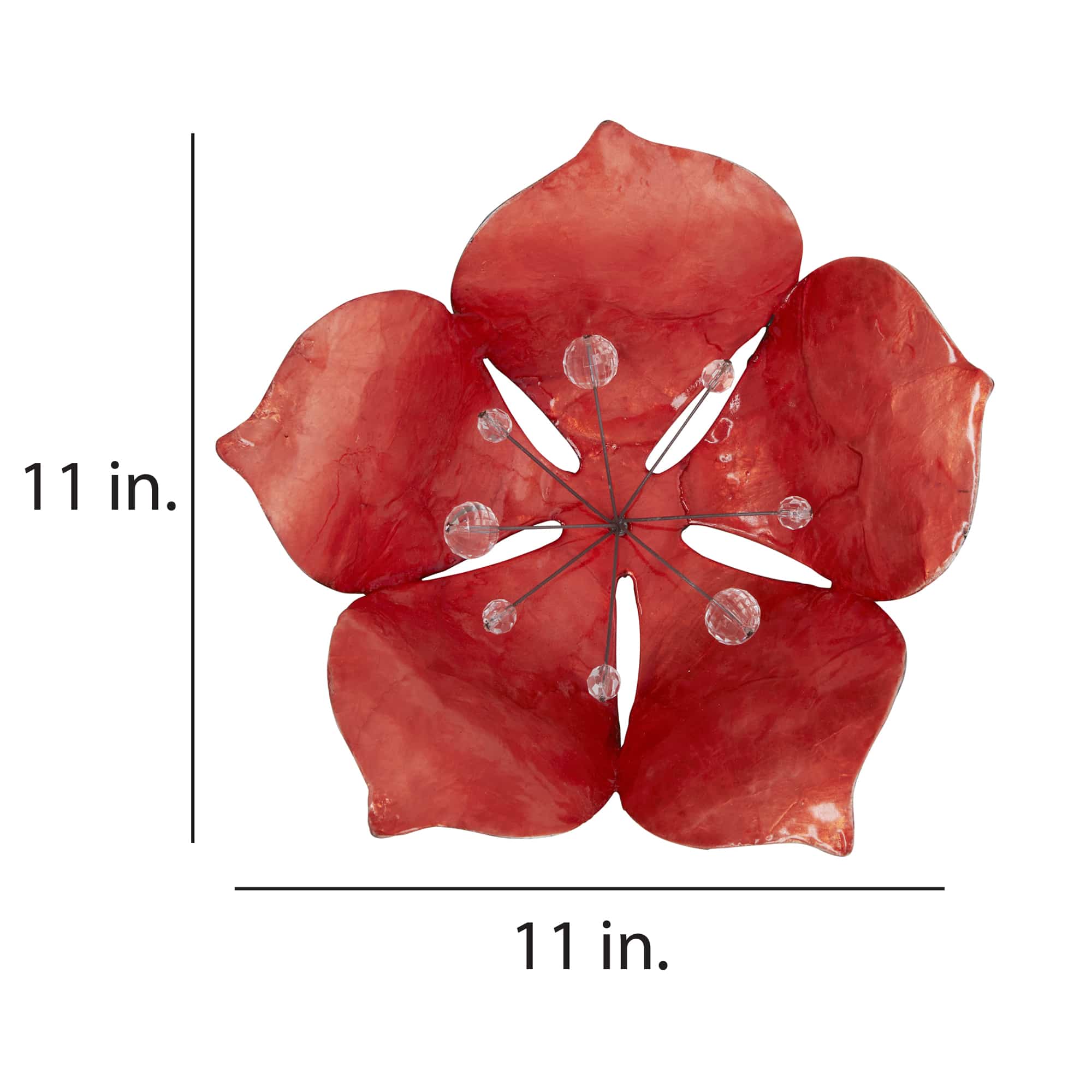
 Bold and colorful, these wall flowers can set by themselves or in a group. The mix of materials such as capiz shell and wrought iron enhances the primary color of the flower by creating shading and shadows. But the artisans took another step by shaping a wrought iron frame into the basic shape of a lily opening itself to the sky. The basic frame of the wall flower is created using tin, which is powder coated as a black finish. The frame is reinforced using wrought iron wire along the inner edge. Capiz is an oyster shell and the primary purpose of the oyster is as a source of food. However, the by-product, the shell, can be used for decoration. Due to it being a natural material, the natural colors of the capiz can come through as tans and browns underneath the paint. The shell is then painted the bold colors you see. Finally, the piece is adorned with translucent balls attached using a wrought iron wire.
Bold and colorful, these wall flowers can set by themselves or in a group. The mix of materials such as capiz shell and wrought iron enhances the primary color of the flower by creating shading and shadows. But the artisans took another step by shaping a wrought iron frame into the basic shape of a lily opening itself to the sky. The basic frame of the wall flower is created using tin, which is powder coated as a black finish. The frame is reinforced using wrought iron wire along the inner edge. Capiz is an oyster shell and the primary purpose of the oyster is as a source of food. However, the by-product, the shell, can be used for decoration. Due to it being a natural material, the natural colors of the capiz can come through as tans and browns underneath the paint. The shell is then painted the bold colors you see. Finally, the piece is adorned with translucent balls attached using a wrought iron wire. -
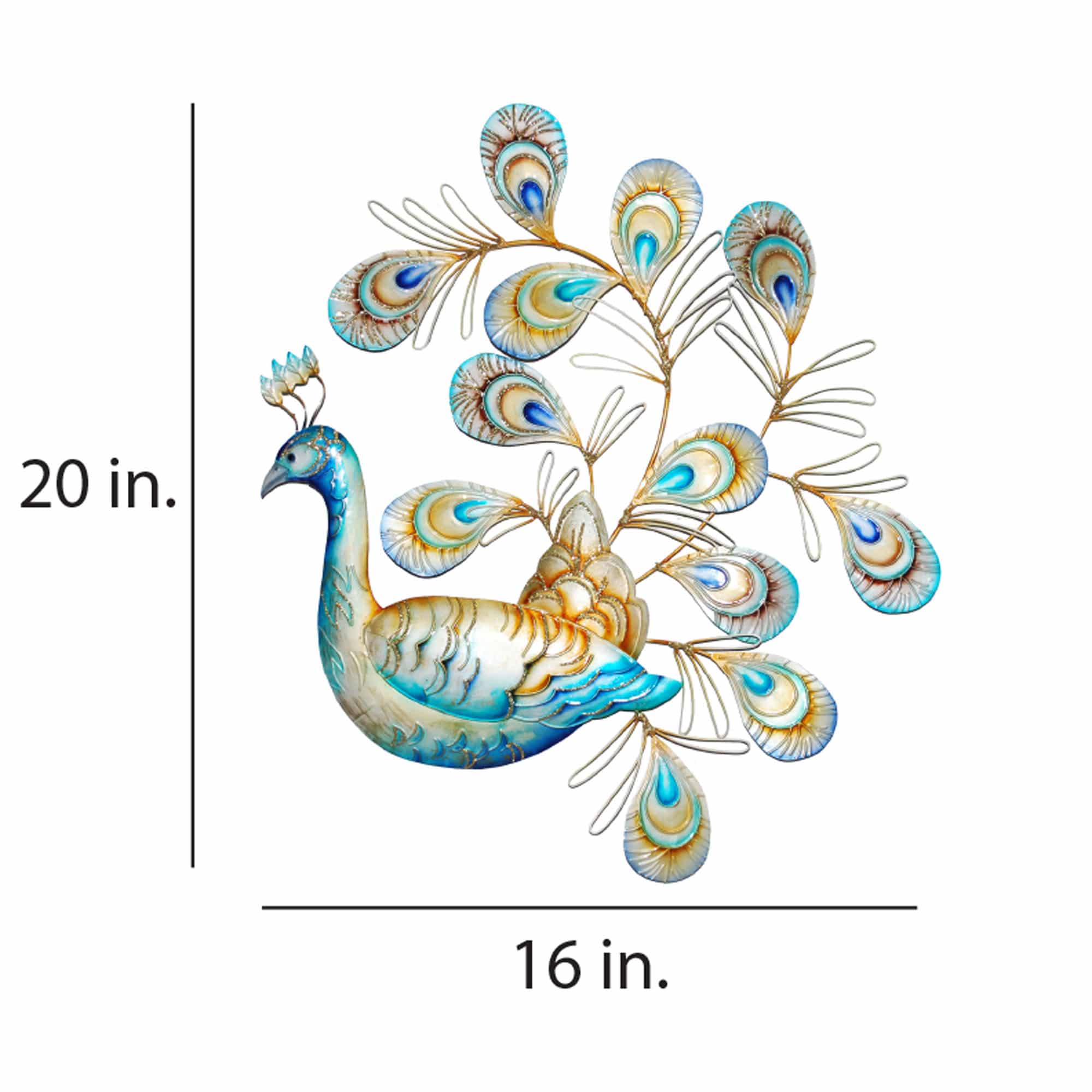
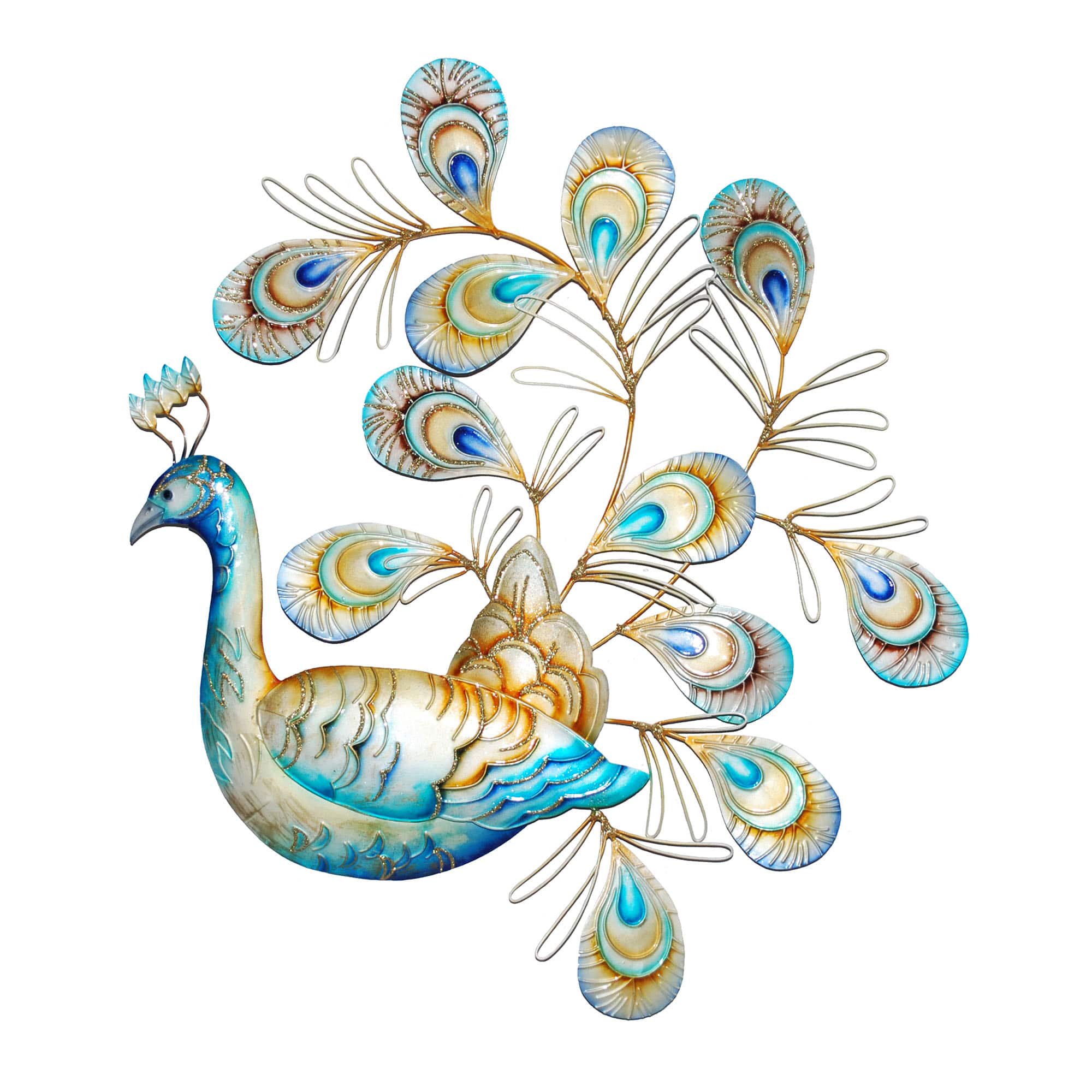 Tailfeathers raised, this Indian peacock is strutting his stuff. On display is its iridescent blue and green, metallic-colored, plumage. Throughout its tailfeathers, the artists drew in the peacock's distinctive eyespots, with the eye itself in different colors. The chest of the bird is crafted from capiz shell, carefully painted in the blues and greens this bird is known for. It fits perfectly within any decor style and will add the finishing touch to its surroundings. The basic frame of this piece is created using tin, which is powder coated with a black finish. The frame is reinforced using tin wire along the inner edge. The front of the body is adorned with capiz. Capiz is an oyster shell and the primary purpose of the oyster is as a source of food. However, the by-product, the shell, can be used for decoration. Due to it being a natural material, the natural colors of the capiz may come through as tans and browns underneath the hand-painted surface.
Tailfeathers raised, this Indian peacock is strutting his stuff. On display is its iridescent blue and green, metallic-colored, plumage. Throughout its tailfeathers, the artists drew in the peacock's distinctive eyespots, with the eye itself in different colors. The chest of the bird is crafted from capiz shell, carefully painted in the blues and greens this bird is known for. It fits perfectly within any decor style and will add the finishing touch to its surroundings. The basic frame of this piece is created using tin, which is powder coated with a black finish. The frame is reinforced using tin wire along the inner edge. The front of the body is adorned with capiz. Capiz is an oyster shell and the primary purpose of the oyster is as a source of food. However, the by-product, the shell, can be used for decoration. Due to it being a natural material, the natural colors of the capiz may come through as tans and browns underneath the hand-painted surface. -
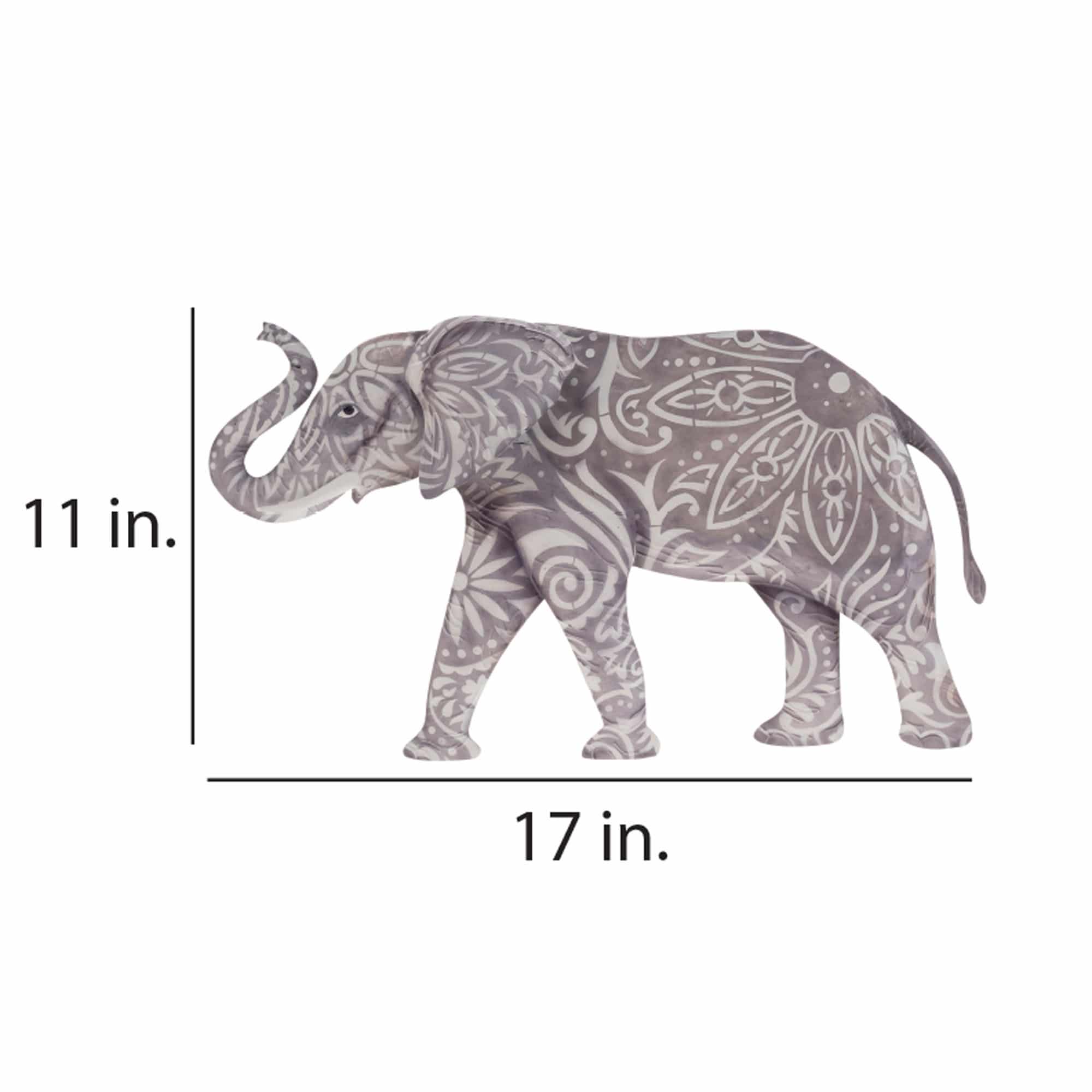
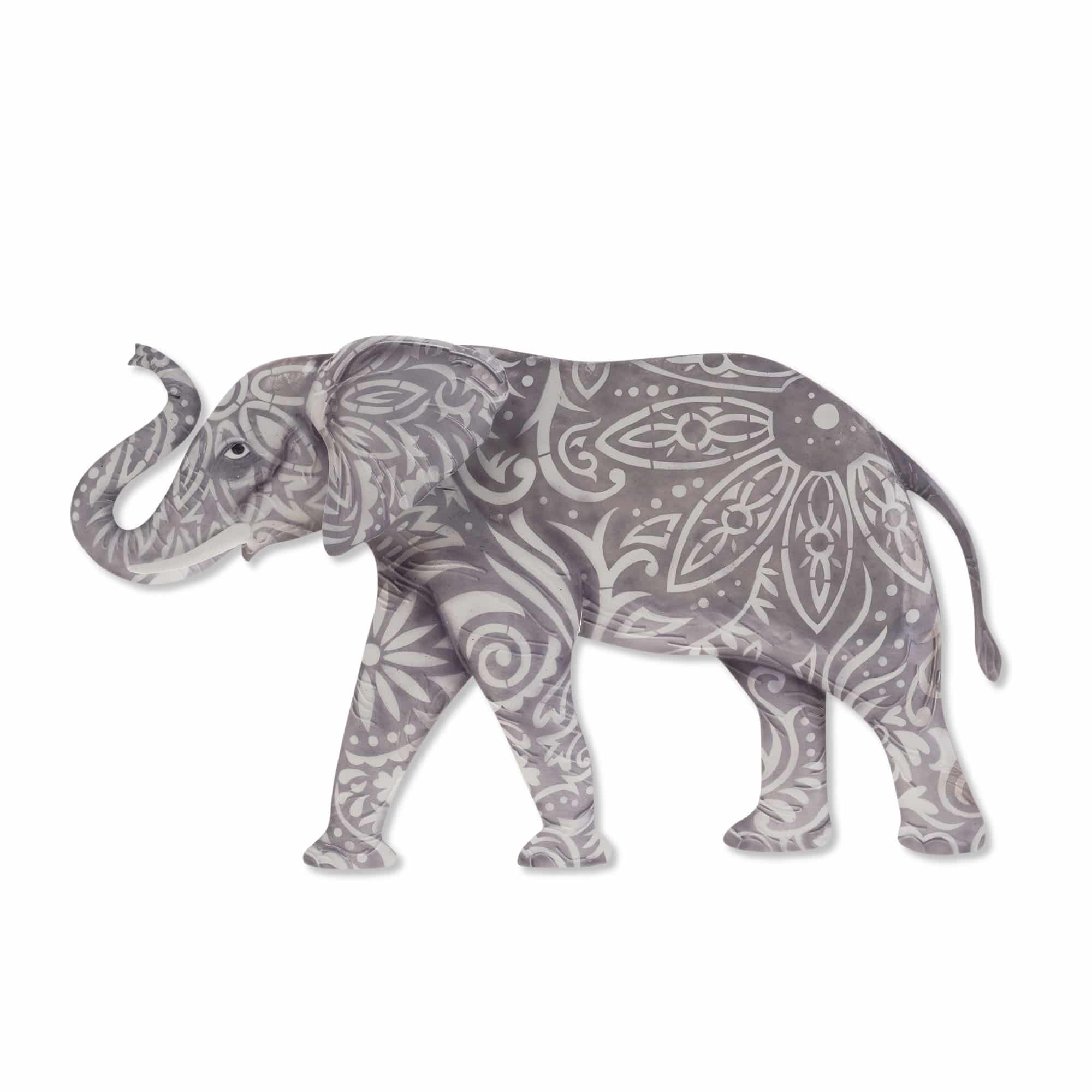 According to feng shui, an elephant with its trunk raised will shower good luck to those around it. It is a symbol for intelligence, curiosity, kindness and strength. The basic shape of this handcrafted metal elephant has its powerful trunk raised due to the importance of the symbolism. Furthermore, the artisan hand-paints the body in a colorful pattern influenced by designs from different Eastern cultures. Placing such a symbol near a door is said to welcome beneficial energy into that space. The basic frame of the is created using tin, which is powder coated with a black finish. The frame is reinforced using tin wire along the inner edge. Capiz is an oyster shell and the primary purpose of the oyster is as a source of food. However, the by-product, the shell, can be used for decoration. Due to it being a natural material, the natural colors of the capiz come through as tans and browns underneath the paint. The shell is then painted the bold colors you see. The entire front facing piece is carefully hand-painted.
According to feng shui, an elephant with its trunk raised will shower good luck to those around it. It is a symbol for intelligence, curiosity, kindness and strength. The basic shape of this handcrafted metal elephant has its powerful trunk raised due to the importance of the symbolism. Furthermore, the artisan hand-paints the body in a colorful pattern influenced by designs from different Eastern cultures. Placing such a symbol near a door is said to welcome beneficial energy into that space. The basic frame of the is created using tin, which is powder coated with a black finish. The frame is reinforced using tin wire along the inner edge. Capiz is an oyster shell and the primary purpose of the oyster is as a source of food. However, the by-product, the shell, can be used for decoration. Due to it being a natural material, the natural colors of the capiz come through as tans and browns underneath the paint. The shell is then painted the bold colors you see. The entire front facing piece is carefully hand-painted. -
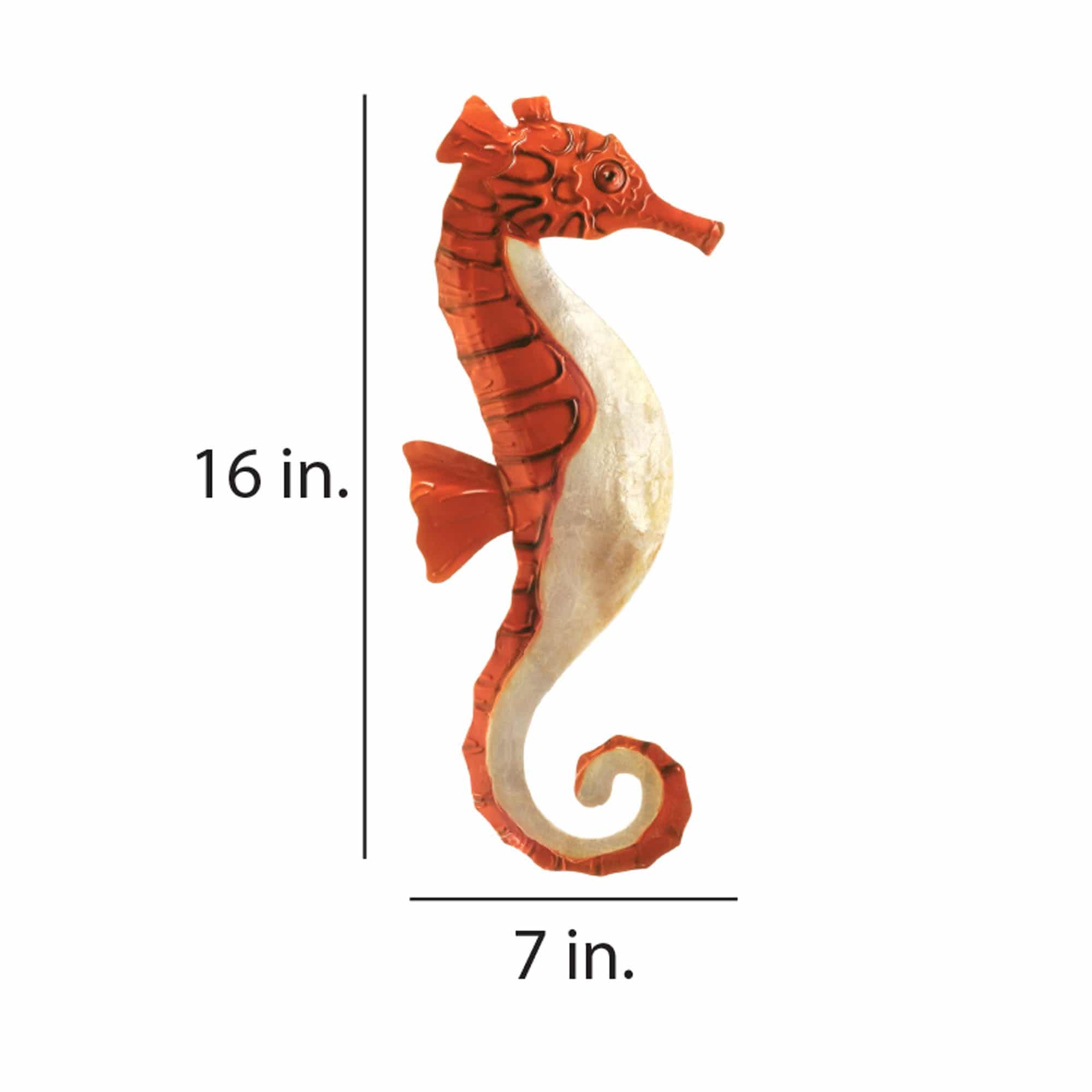
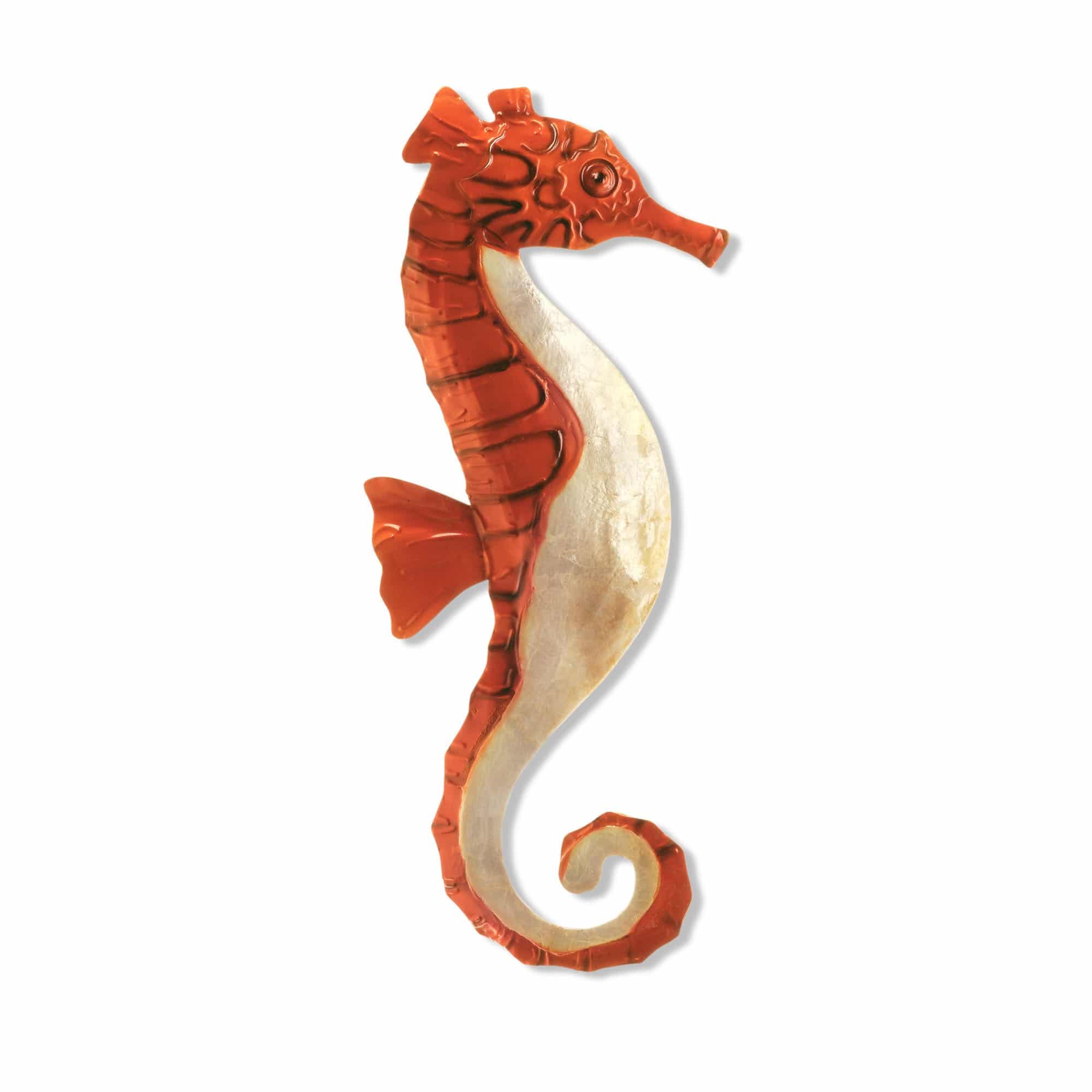 The seahorse has captured the minds and imaginations of people across all cultures for thousands of years. Seen as a symbol of good luck, strength and safety, this unique and beautiful animal is as charming as it is mysterious. The artist captures the beauty of the seahorse with a raised fine, high shine, hand-painted finish, and elegant mother of pearl chest and forefront. The basic frame of the wall seahorse is created using tin, which is powder coated as a black finish. Capiz is an oyster shell and the primary purpose of the oyster is as a source of food. However, the by-product, the shell, can be used for decoration. Due to it being a natural material, the natural colors of the capiz can come through as tans and browns.
The seahorse has captured the minds and imaginations of people across all cultures for thousands of years. Seen as a symbol of good luck, strength and safety, this unique and beautiful animal is as charming as it is mysterious. The artist captures the beauty of the seahorse with a raised fine, high shine, hand-painted finish, and elegant mother of pearl chest and forefront. The basic frame of the wall seahorse is created using tin, which is powder coated as a black finish. Capiz is an oyster shell and the primary purpose of the oyster is as a source of food. However, the by-product, the shell, can be used for decoration. Due to it being a natural material, the natural colors of the capiz can come through as tans and browns. -
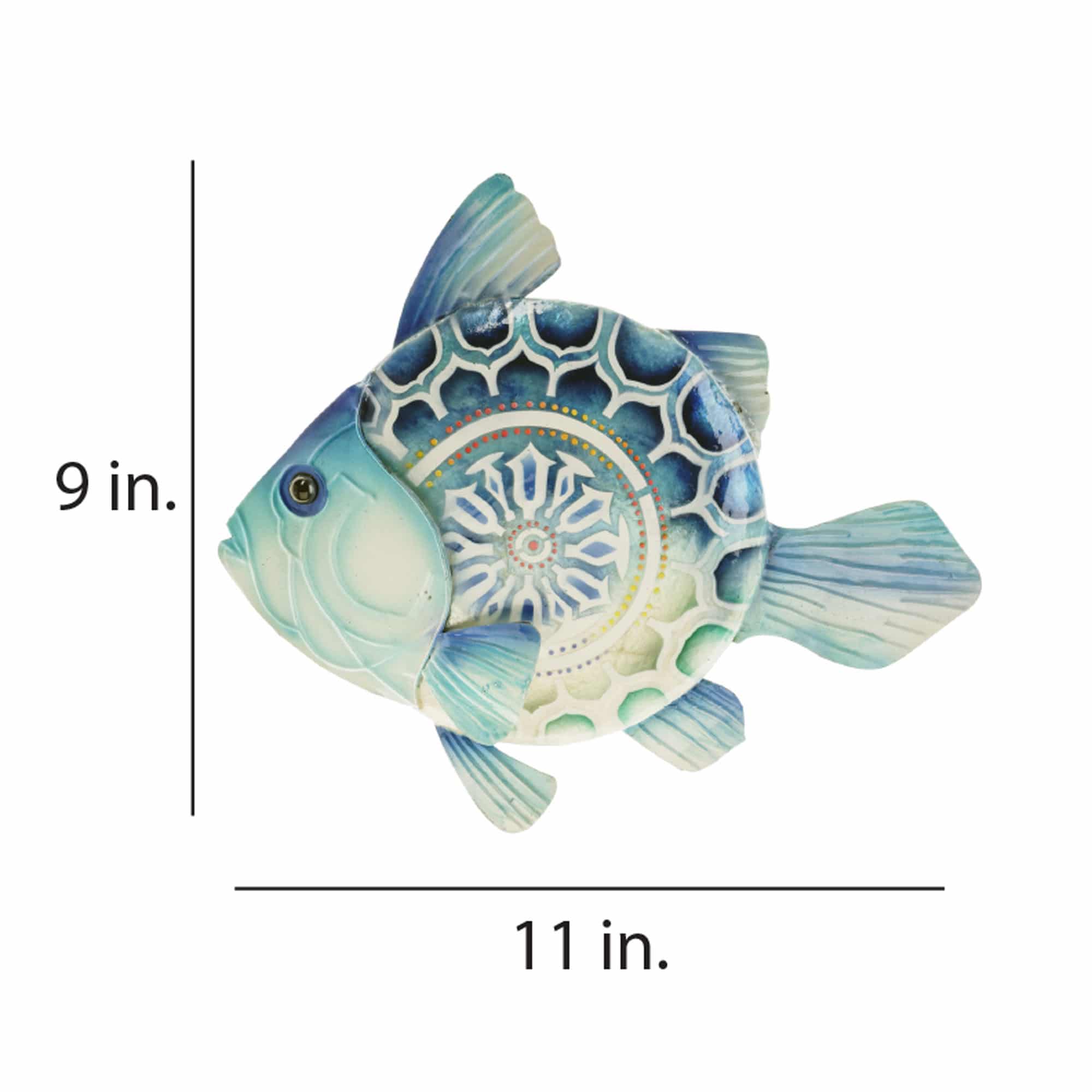
 This fish is an artist's interpretation of the blue sea bass. The rich blue tones are common not only on the fish, but also the water within which it resides. The spiky fines and the scaly skin are also captured by the artist. The center of the fish is most interesting as it is adorned with capiz shell, which is hand-painted in wavy lines, representing the movement of the ocean as well as the fish. This piece will bring in color and design to your space and a smile to your face. The basic frame of the wall fish is created using tin, which is powder coated as a black finish. The frame is reinforced using wrought iron wire along the inner edge. Capiz is an oyster shell and the primary purpose of the oyster is as a source of food. However, the by-product, the shell, can be used for decoration. Due to it being a natural material, the natural colors of the capiz can come through as tans and browns underneath the paint.
This fish is an artist's interpretation of the blue sea bass. The rich blue tones are common not only on the fish, but also the water within which it resides. The spiky fines and the scaly skin are also captured by the artist. The center of the fish is most interesting as it is adorned with capiz shell, which is hand-painted in wavy lines, representing the movement of the ocean as well as the fish. This piece will bring in color and design to your space and a smile to your face. The basic frame of the wall fish is created using tin, which is powder coated as a black finish. The frame is reinforced using wrought iron wire along the inner edge. Capiz is an oyster shell and the primary purpose of the oyster is as a source of food. However, the by-product, the shell, can be used for decoration. Due to it being a natural material, the natural colors of the capiz can come through as tans and browns underneath the paint. -
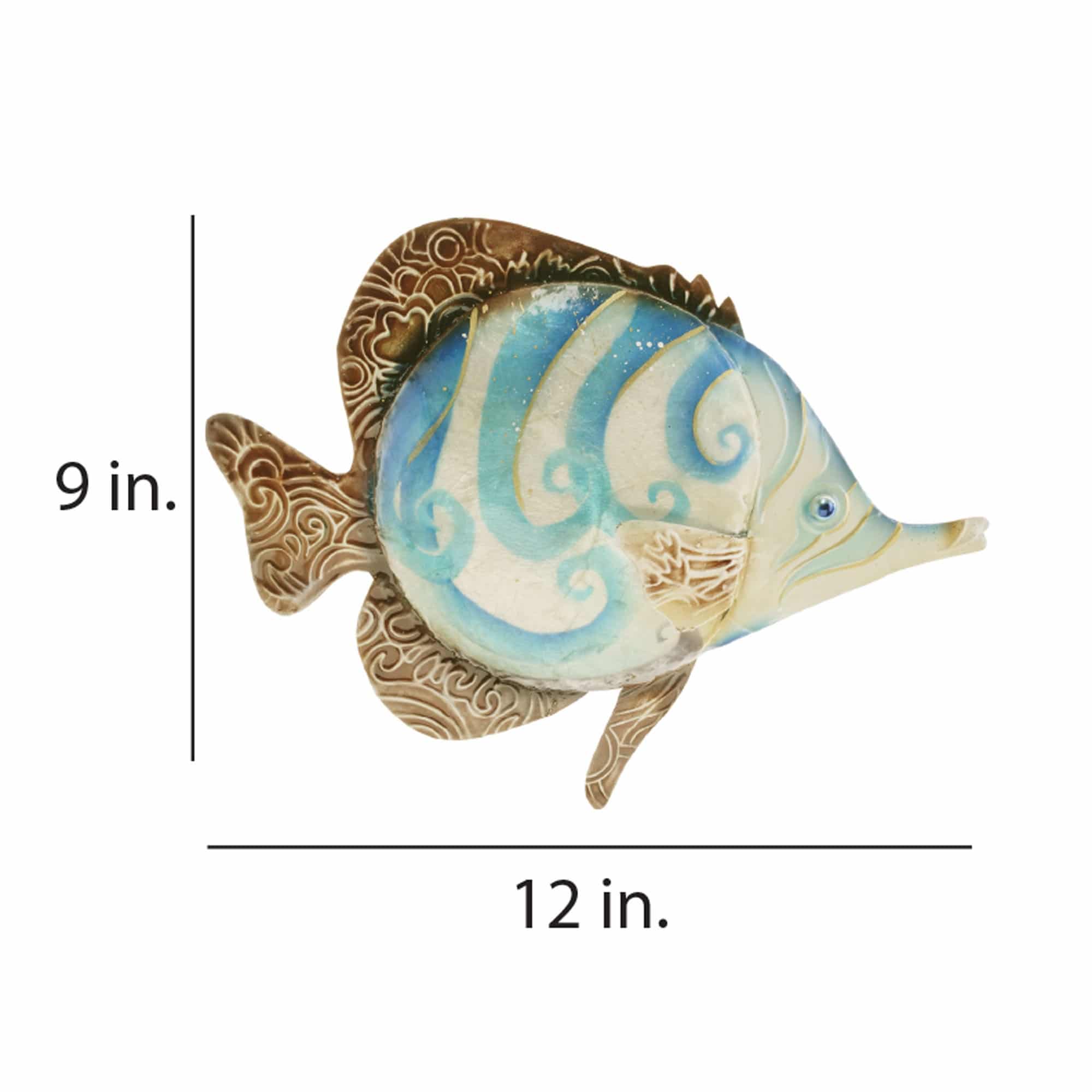
 This fish was inspired by the Copperband Butterfly Fish. Though the name is a mouthful, the artist did capture the strips, colors, broad fins, and the beak that this fish is known for. The blue and pearl swirls contrast with its deeper bronze fins. Those fins are further enhanced with a swirled design, creating a very complex piece. The results is a piece rich in design and color. The basic frame of the wall fish is created using tin, which is powder coated as a black finish. The frame is reinforced using wrought iron wire along the inner edge. Capiz is an oyster shell and the primary purpose of the oyster is as a source of food. However, the by-product, the shell, can be used for decoration. Due to it being a natural material, the natural colors of the capiz can come through as tans and browns underneath the paint.
This fish was inspired by the Copperband Butterfly Fish. Though the name is a mouthful, the artist did capture the strips, colors, broad fins, and the beak that this fish is known for. The blue and pearl swirls contrast with its deeper bronze fins. Those fins are further enhanced with a swirled design, creating a very complex piece. The results is a piece rich in design and color. The basic frame of the wall fish is created using tin, which is powder coated as a black finish. The frame is reinforced using wrought iron wire along the inner edge. Capiz is an oyster shell and the primary purpose of the oyster is as a source of food. However, the by-product, the shell, can be used for decoration. Due to it being a natural material, the natural colors of the capiz can come through as tans and browns underneath the paint. -


Classically painted roses adorn this set of three butterflies. The traditional pattern brings the garden indoors. Painted on mother of pearl oyster shells, the vibrant roses pop, adding color and charm.
The basic frame of the butterfly is created using tin, which is powder-coated with a black finish and makes this piece safe to use outdoors. The edges of the frame are reinforced using thicker tin wire. The front of this piece is adorned in areas with capiz shell, an oyster native to the Philippines, before being hand-painted and sealed with a water-based sealant. The primary purpose of this oyster to provide a source of food, however, the shell is a sustainable by-product that can be used for decoration. The capiz shell subtly replicates the reflective qualities of butterflies in nature. The entire piece is lightweight and has an eyelet in the back allowing it to be hung using a finishing nail, command strip, or a push pin. Due to it being a natural material, the organic colors of capiz come through as tans and browns underneath the paint.
-
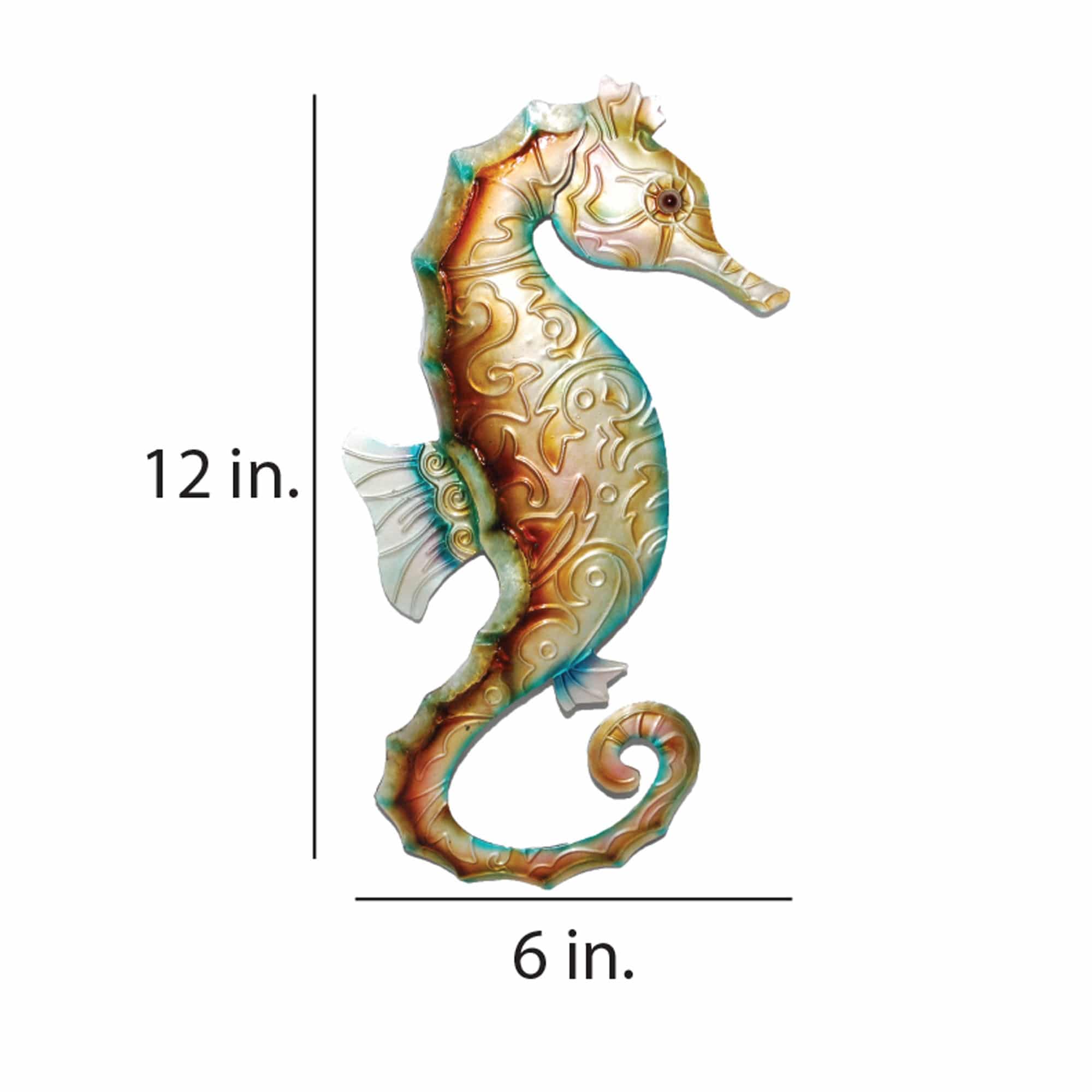
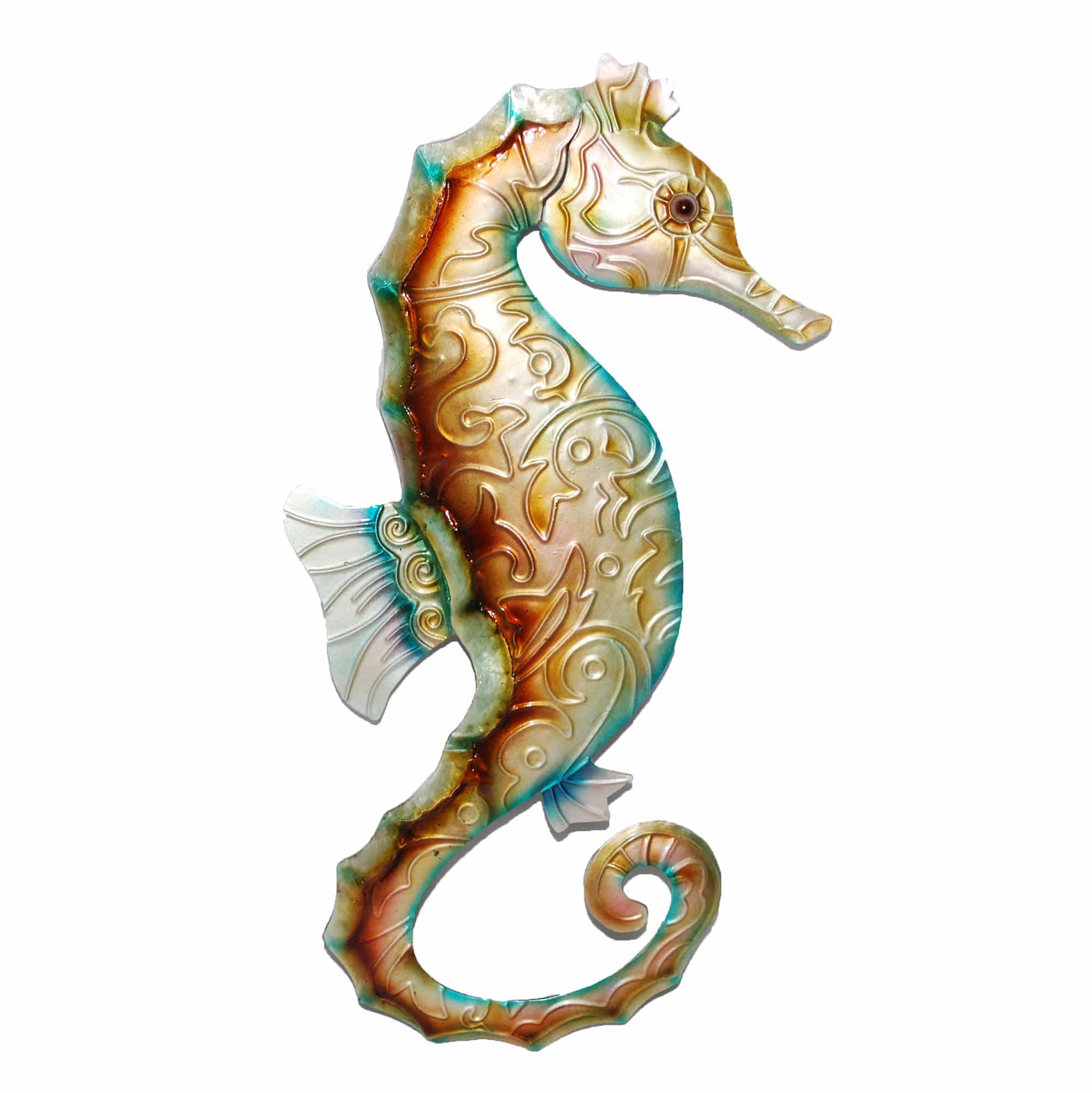 The seahorse has captured the minds and imaginations of people across all cultures for thousands of years. Seen as a symbol of good luck, strength and safety, this unique and beautiful animal is as charming as it is mysterious. The artist captures the beauty of the seahorse with a raised fine, high shine, hand-painted finish, and elegant mother of pearl chest and forefront. The basic frame of the wall seahorse is created using tin, which is powder coated as a black finish. Capiz is an oyster shell and the primary purpose of the oyster is as a source of food. However, the by-product, the shell, can be used for decoration. Due to it being a natural material, the natural colors of the capiz can come through as tans and browns.
The seahorse has captured the minds and imaginations of people across all cultures for thousands of years. Seen as a symbol of good luck, strength and safety, this unique and beautiful animal is as charming as it is mysterious. The artist captures the beauty of the seahorse with a raised fine, high shine, hand-painted finish, and elegant mother of pearl chest and forefront. The basic frame of the wall seahorse is created using tin, which is powder coated as a black finish. Capiz is an oyster shell and the primary purpose of the oyster is as a source of food. However, the by-product, the shell, can be used for decoration. Due to it being a natural material, the natural colors of the capiz can come through as tans and browns. -
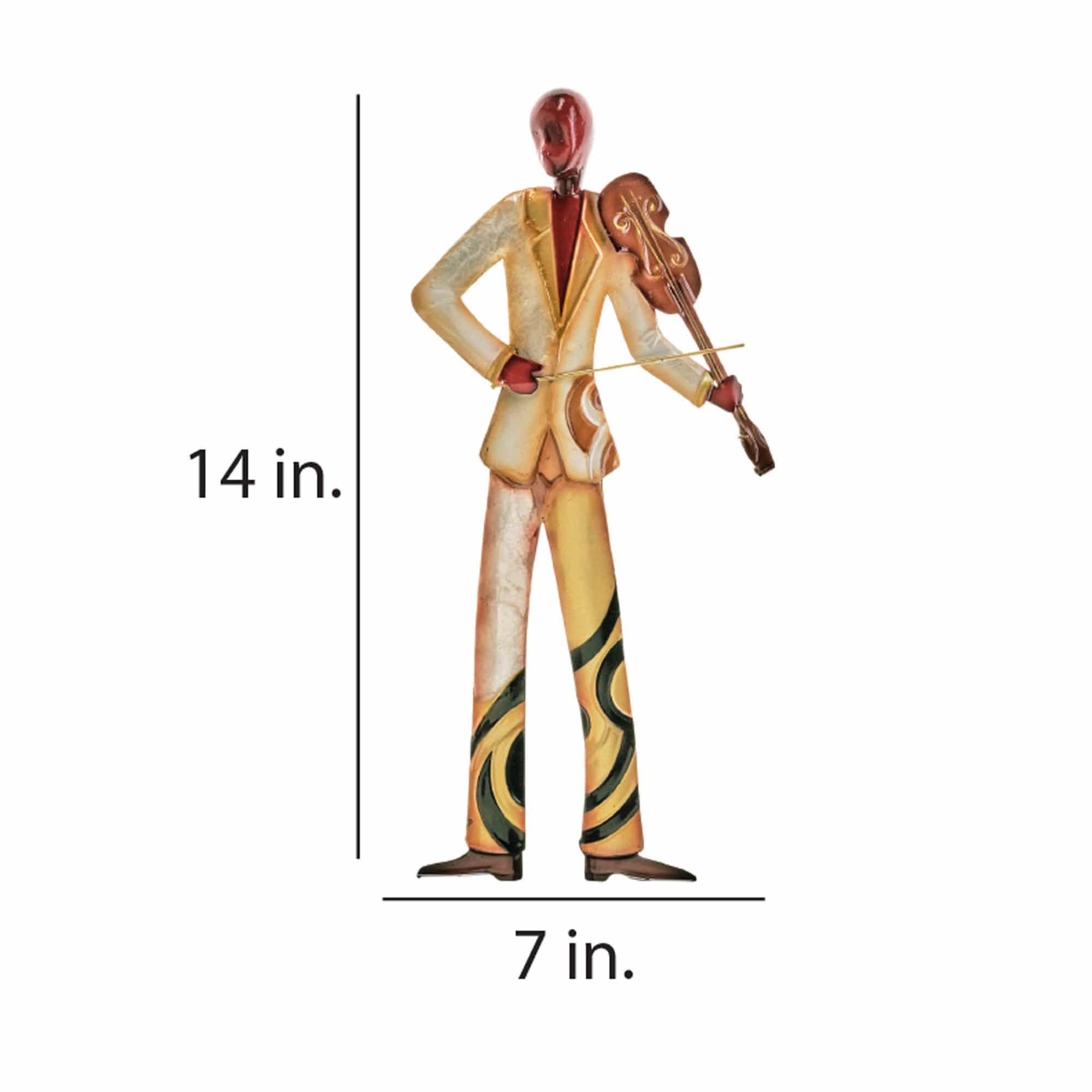
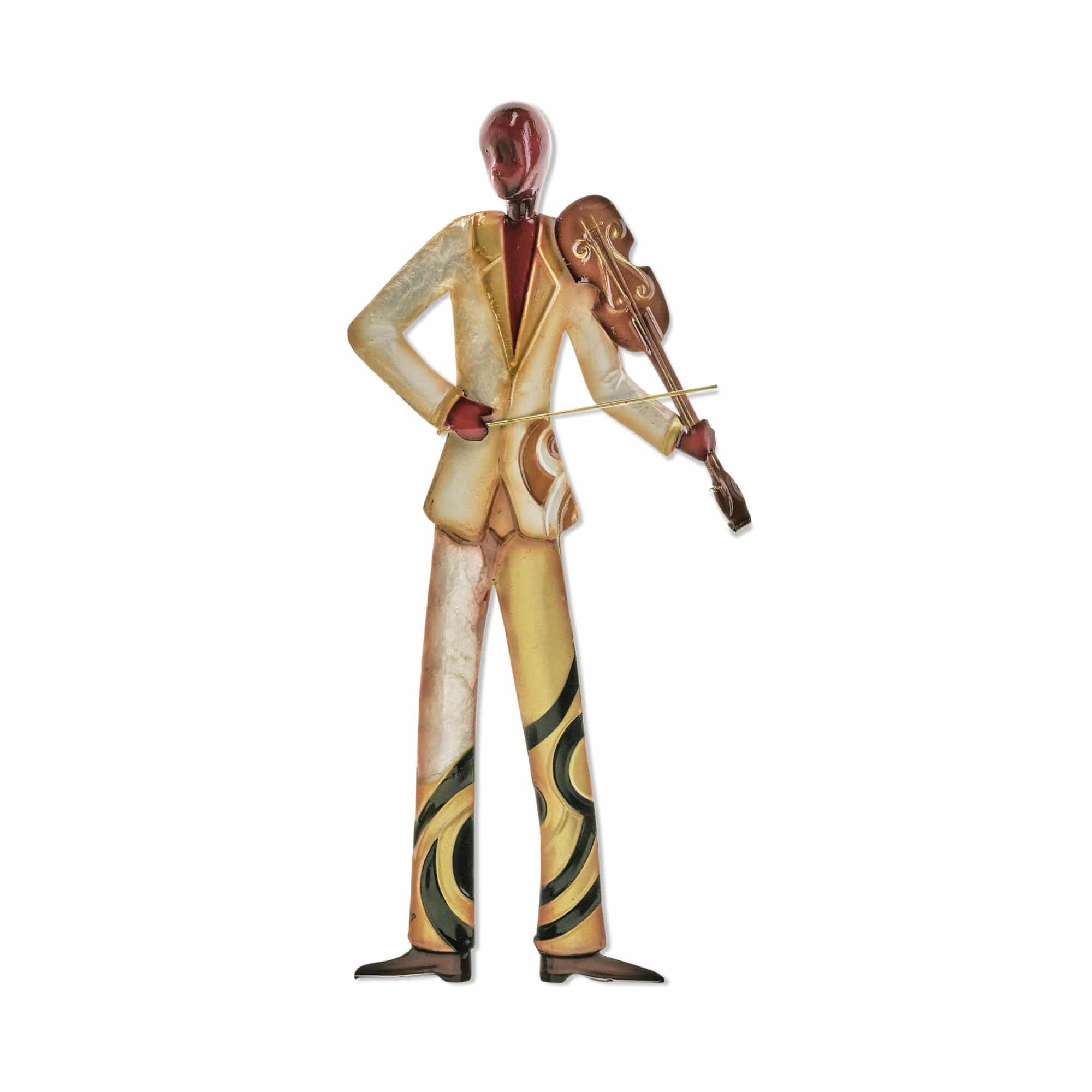
The violin transcends time. Used in both formal and festive settings, this instrument is used to convey a journey or to simply get people up to dance. The artisans bring both into one piece of art. The formal wear of the violinist invokes the classics while the color and shading of the clothing represents the festive. The well-dressed violin player is partially adorned with capiz giving it a shimmer as it reflects light, again bringing out the festive side of the instrument.
The frame of the Violin Player Wall Decor is created using tin, which is powder coated in a black finish. The frame is reinforced using wrought iron wire inner edge or outer edge. Capiz is an oyster shell and the primary purpose of the oyster is as a source of food. However, the by-product, the shell, can be used for decoration. Due to it being a natural material, the natural colors of the capiz can come through as tans and browns underneath the paint.
-
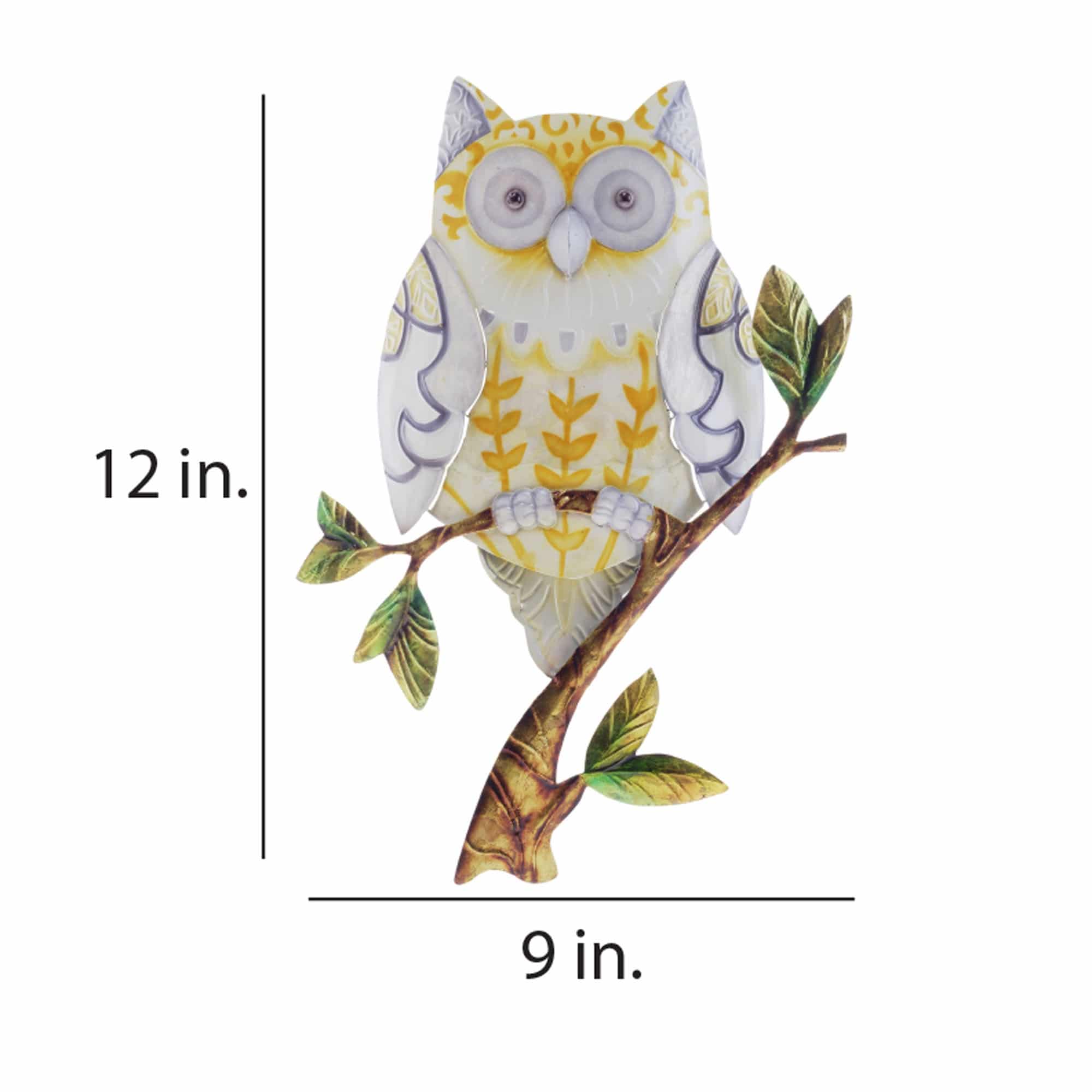
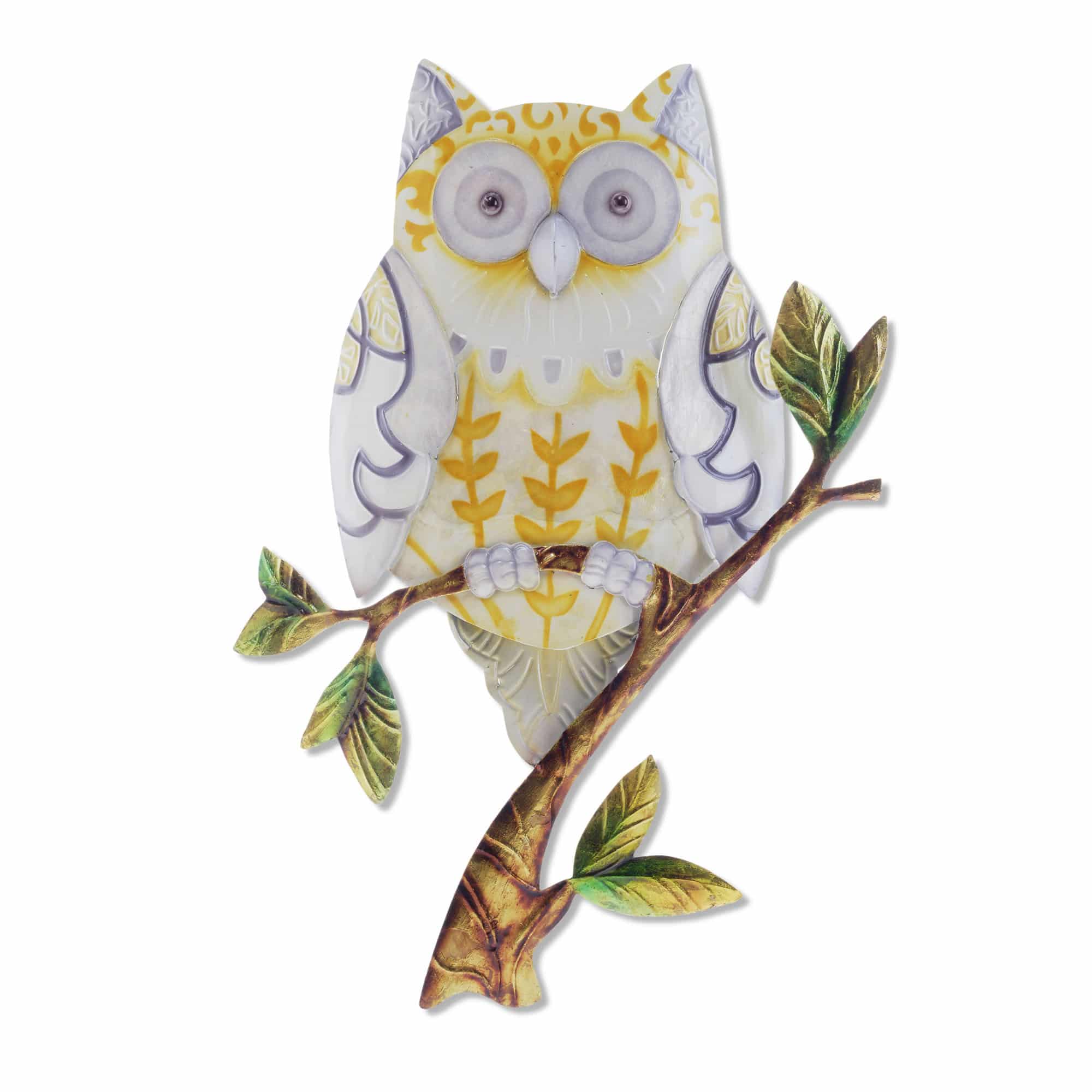 The owl was a bird of prophecy and wisdom in many ancient cultures. Its wide eyes seem to miss nothing and when an owl moves it seems calculated. Even though the colors and designs on the owl are human interpretations, the perched look is defiantly natural. The artist uses capiz shell on the wings to highlight the reflective nature of some of the owl's feathers. The basic frame of the owl is created using tin, which is powder coated with a black finish. The frame is reinforced using tin wire along the inner edge. Capiz is an oyster shell and the primary purpose of the oyster is as a source of food. However, the by-product, the shell, can be used for decoration.
The owl was a bird of prophecy and wisdom in many ancient cultures. Its wide eyes seem to miss nothing and when an owl moves it seems calculated. Even though the colors and designs on the owl are human interpretations, the perched look is defiantly natural. The artist uses capiz shell on the wings to highlight the reflective nature of some of the owl's feathers. The basic frame of the owl is created using tin, which is powder coated with a black finish. The frame is reinforced using tin wire along the inner edge. Capiz is an oyster shell and the primary purpose of the oyster is as a source of food. However, the by-product, the shell, can be used for decoration. -
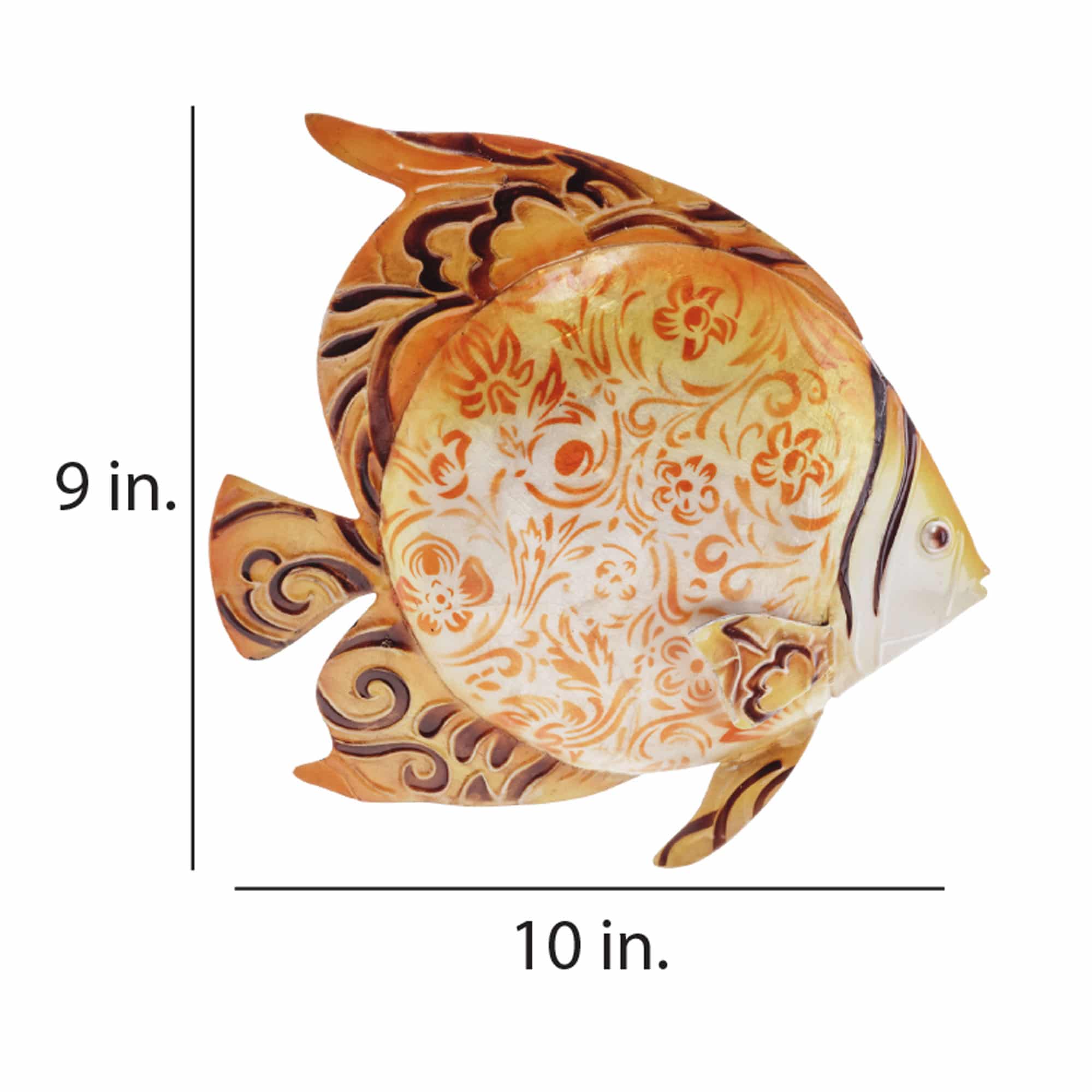
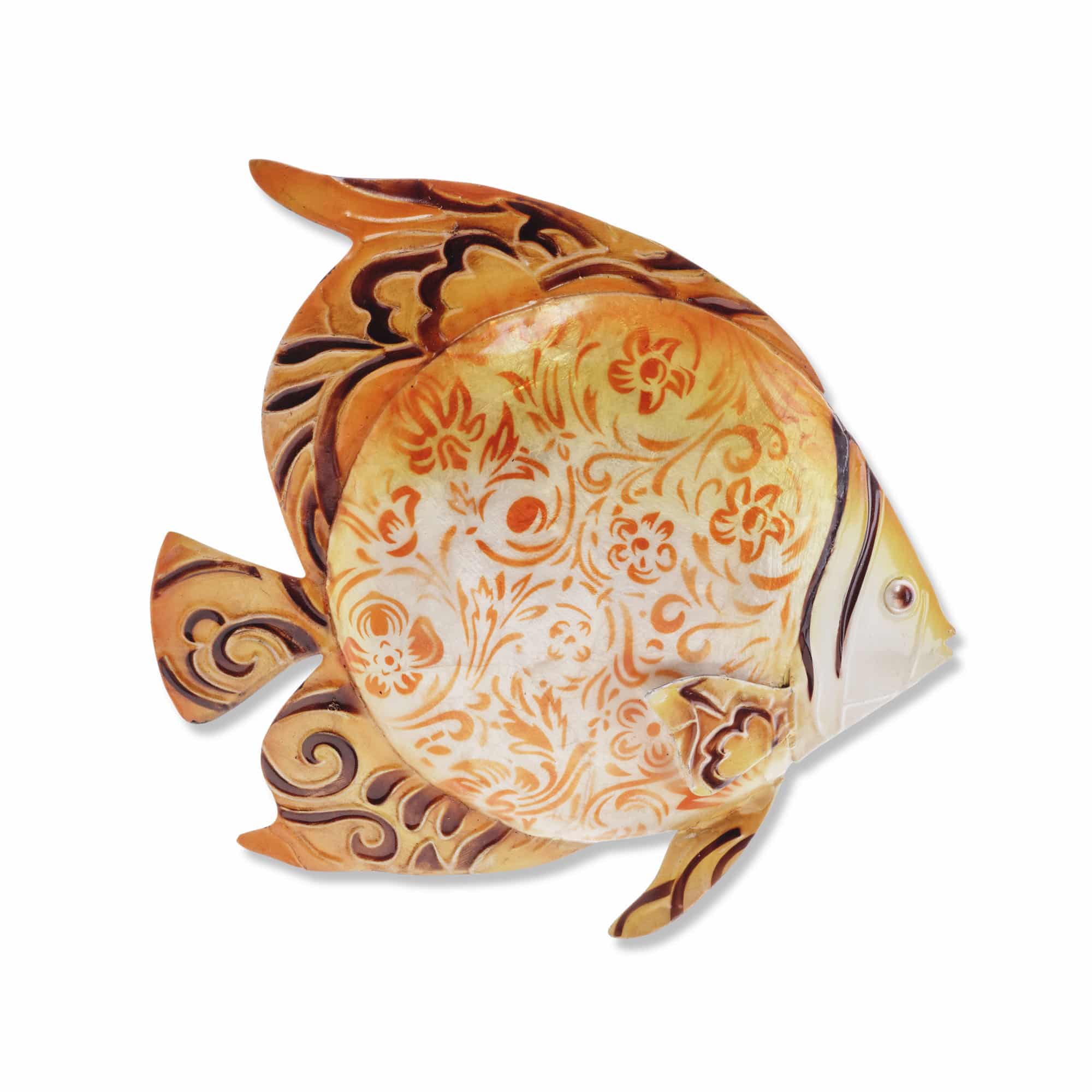 It's big. It's round and it's called an Opah. It looks like a goldfish that seriously outgrew its bowl. The Opah's bright orange is represented in this piece. Instead of spots, the artist took license and painted intricate floral patterns on top of capiz shells. The artist continues by pressing patterns into the tin both in the fins and the face of this magnificent fish. The basic frame of the wall fish is created using tin, which is powder coated as a black finish. The frame is reinforced using wrought iron wire along the inner edge. Capiz is an oyster shell and the primary purpose of the oyster is as a source of food. However, the by-product, the shell, can be used for decoration. Due to it being a natural material, the natural colors of the capiz can come through as tans and browns underneath the paint.
It's big. It's round and it's called an Opah. It looks like a goldfish that seriously outgrew its bowl. The Opah's bright orange is represented in this piece. Instead of spots, the artist took license and painted intricate floral patterns on top of capiz shells. The artist continues by pressing patterns into the tin both in the fins and the face of this magnificent fish. The basic frame of the wall fish is created using tin, which is powder coated as a black finish. The frame is reinforced using wrought iron wire along the inner edge. Capiz is an oyster shell and the primary purpose of the oyster is as a source of food. However, the by-product, the shell, can be used for decoration. Due to it being a natural material, the natural colors of the capiz can come through as tans and browns underneath the paint. -
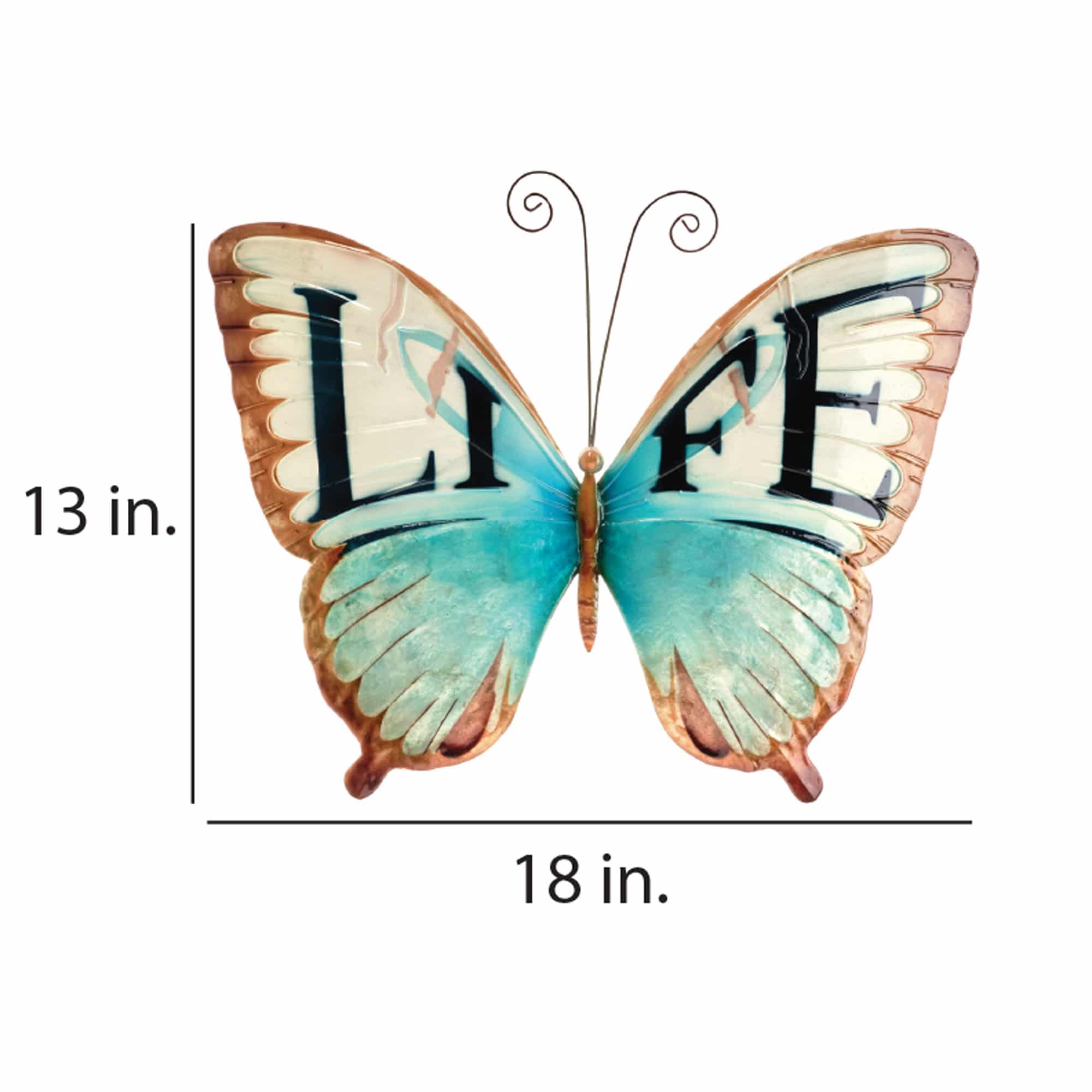
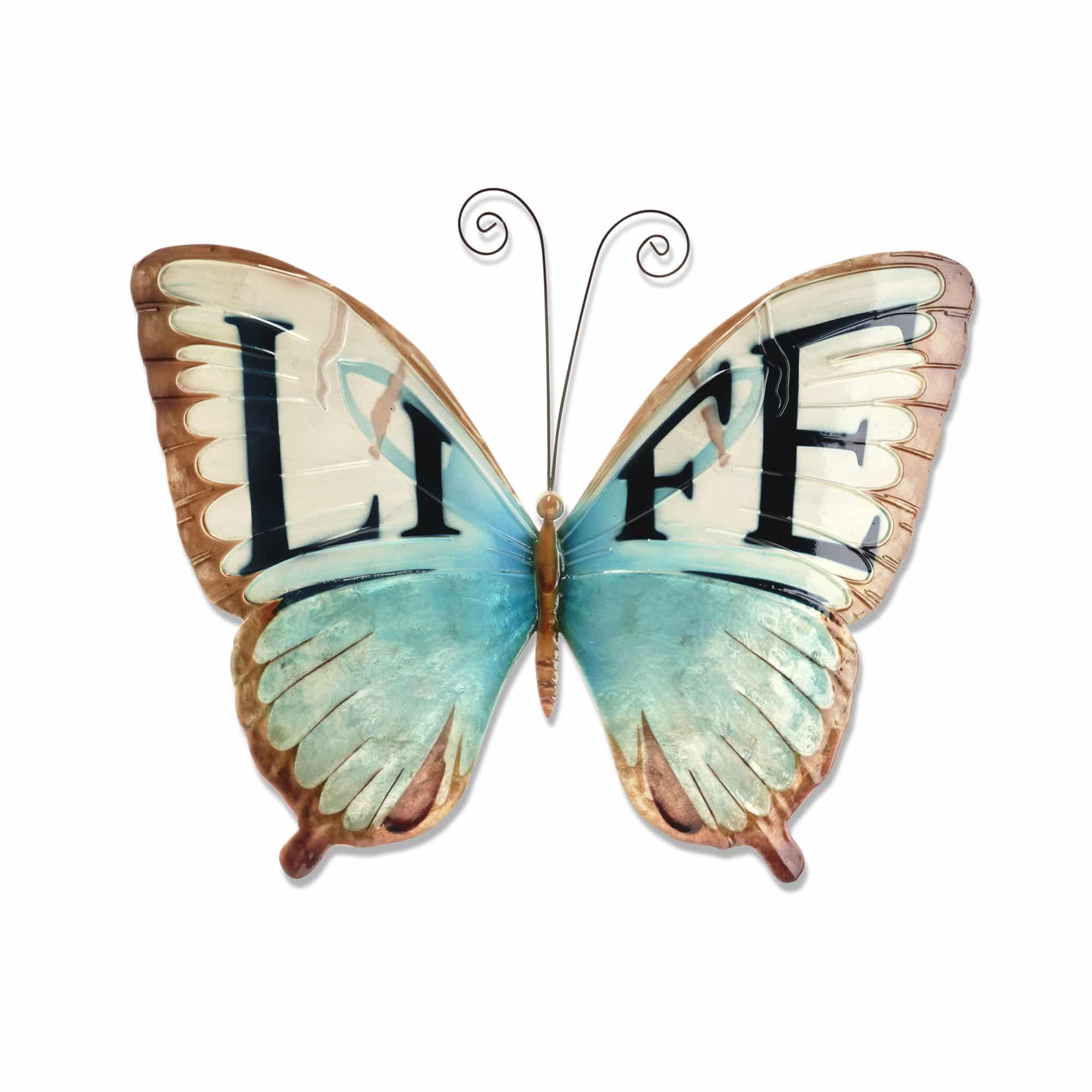
Shedding its cocoon, the butterfly is a strong symbol of rebirth, thus the butterfly is entrenched in many myths and legends around the world about immortality. In many eastern cultures, the color blue also is a symbol of immortality and is used to represent life. As to contrast the subtle meanings behind this butterfly, the word eLife' radiates from the butterfly's very core. This elegant butterfly, highlighted with blue and browns, states clearly that this beautiful creation represents life.
The basic frame of the butterfly is created using tin, which is powder-coated with a black finish and makes this piece safe to use outdoors. The edges of the frame are reinforced using thicker tin wire. The front of this piece is adorned in areas with capiz shell, an oyster native to the Philippines, before being hand-painted and sealed with a water-based sealant. The primary purpose of this oyster to provide a source of food, however, the shell is a sustainable by-product that can be used for decoration. The capiz shell subtly replicates the reflective qualities of butterflies in nature. The entire piece is lightweight and has an eyelet in the back allowing it to be hung using a finishing nail, command strip, or a push pin. Due to it being a natural material, the organic colors of capiz come through as tans and browns underneath the paint.



